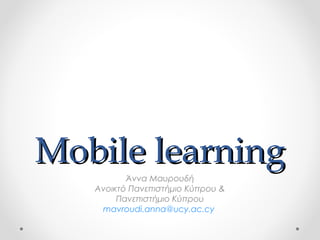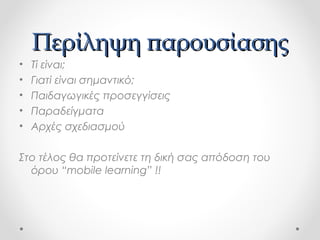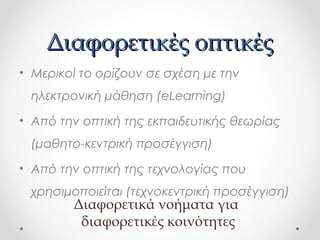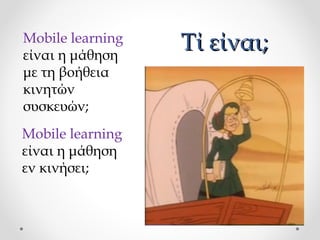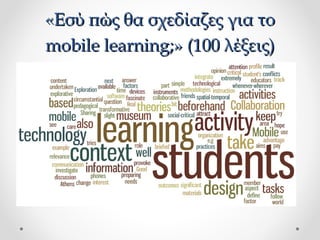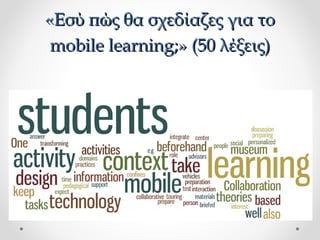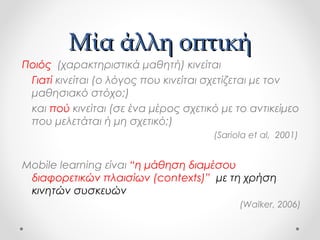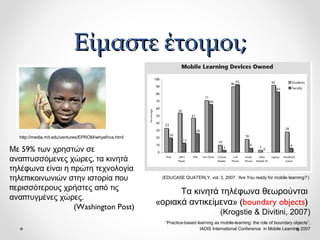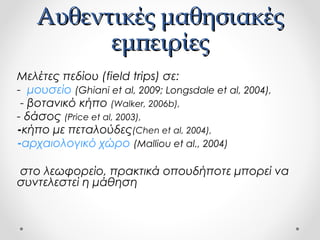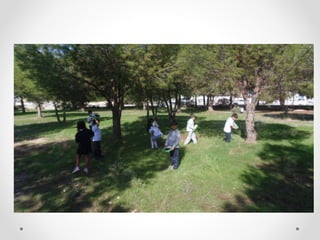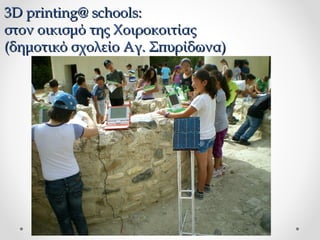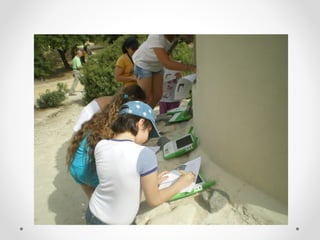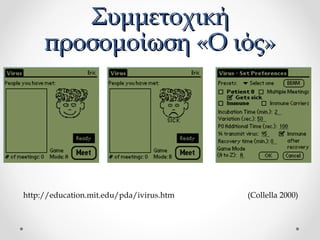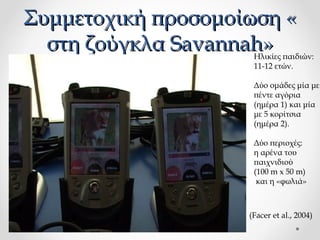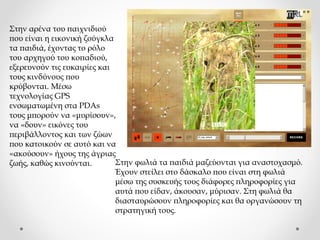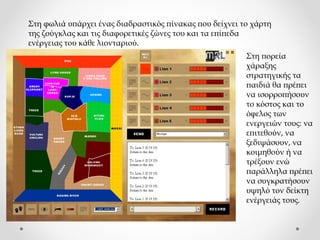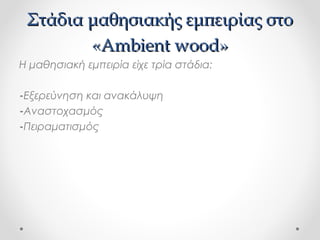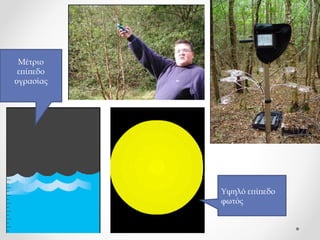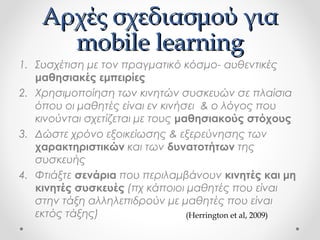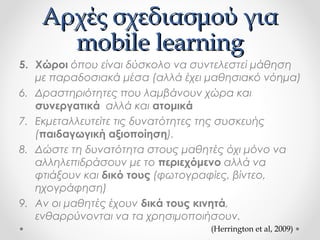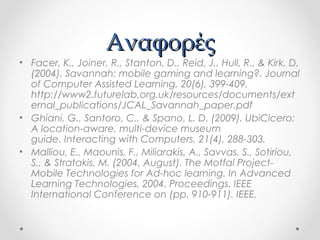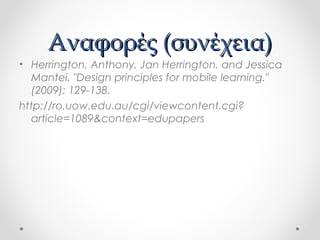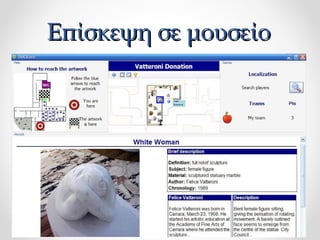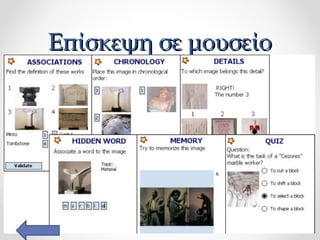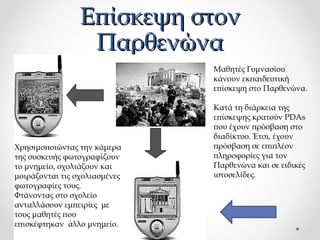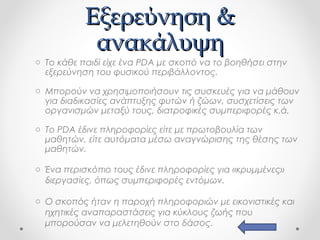More Related Content What's hot (20) PPT
72o ╬Ø╬ĘŽĆ╬╣╬▒╬│Žē╬│╬Ą╬»╬┐ ╬Ā╬▒ŽäŽüŽÄ╬Į ╬Ø╬Ł╬ĄŽé ╬ż╬ĄŽć╬Į╬┐╬╗╬┐╬│╬»╬ĄŽé 2014 -15
Patritsia Tsampazi ╠²
DOC
╬ö╬╣╬┤╬▒╬║Žä╬╣╬║Žī Žā╬Ą╬Į╬¼Žü╬╣╬┐ ŽāŽä╬Ę ╬£╬Ą╬╗╬ŁŽä╬Ę ╬Ā╬ĄŽü╬╣╬▓╬¼╬╗╬╗╬┐╬ĮŽä╬┐Žé ╬æ╬äŽä╬¼╬Š╬Ę-╬¤╬╣ ╬┐╬╣╬║╬┐╬│╬Ł╬Į╬Ą╬╣╬ĄŽé ŽäŽē╬Į ╬ČŽÄŽē╬Į
Eleni Chrisanthakopoulou ╠²
PPTX
╬Ā╬▒Žü╬┐ŽģŽā╬»╬▒Žā╬Ę ╬Ģ╬║ŽĆ╬▒╬╣╬┤╬ĄŽģŽä╬╣╬║╬┐ŽŹ ╬Ż╬Ą╬Į╬▒Žü╬»╬┐Žģ
Maria Dimou ╠²
DOC
╬Ā╬╗╬ĘŽü╬┐Žå╬┐Žü╬╣╬║╬« ŽāŽä╬┐ ╬ö╬Ę╬╝╬┐Žä╬╣╬║Žī ŽāŽć╬┐╬╗╬Ą╬»╬┐
Maria Skiadelli ╠²
PDF
╬Ą╬║ŽĆ╬▒╬╣╬┤╬ĄŽģŽä╬╣╬║╬┐ Žā╬Ą╬Į╬▒Žü╬╣╬┐ ╬╝╬Ą╬╗╬ĄŽä╬ĘŽā_Žä╬▒_╬ČŽē╬▒
Georgia Palapela ╠²
PPT
╬Ż╬Ą╬Į╬¼Žü╬╣╬▒-╬£╬╣╬║ŽüŽīŽé ╬┐╬┤╬Ę╬│ŽīŽé ╬│╬╣╬▒ ╬┤╬▒Žā╬║╬¼╬╗╬┐ŽģŽé
Sotiris Terzidis ╠²
PPT
╬Ģ╬»╬╝╬▒╬╣ ŽĆ╬▒╬╣╬┤╬» ╬╝╬╣╬║ŽüŽī, ╬┤╬Ą Žå╬┐╬▓╬¼╬╝╬▒╬╣ Žä╬┐ Žā╬Ą╬╣Žā╬╝Žī
George Markatatos ╠²
PDF
╬Ą╬Į╬┤╬Ą╬╣╬║Žä╬╣╬║Žī Žā╬Ą╬Į╬¼Žü╬╣╬┐ 1
mxatzi ╠²
DOC
╬Ģ╬»╬╝╬▒╬╣ ŽĆ╬▒╬╣╬┤╬» ╬╝╬╣╬║ŽüŽī ŌĆ”╬┤╬Ą Žå╬┐╬▓╬¼╬╝╬▒╬╣ Žä╬┐ Žā╬Ą╬╣Žā╬╝Žī
kotzortzoglou ╠²
DOC
╬║. ŽāŽģ╬Į╬┐Žģ╬╗╬ĘŽā ╬Į╬Ą╬┐╬Ą╬╗╬╗. ╬│╬╗ŽēŽāŽā╬▒ ╬▒╬ä╬│Žģ╬╝╬Į╬▒Žā╬╣╬┐Žģ (╬▒╬╝╬Ą╬▒)
kse30lykeio ╠²
PPT
╬ö╬╣╬┤╬¼Žā╬║╬┐╬ĮŽä╬▒Žé ╬╣ŽāŽä╬┐Žü╬»╬▒ Žä╬Ę╬Į ╬ĄŽĆ╬┐Žć╬« Žä╬┐Žģ ╬┤╬╣╬▒╬┤╬╣╬║ŽäŽŹ╬┐Žģ
Theresa Giakoumatou ╠²
Viewers also liked (10) PPT
╬ŁŽü╬ĄŽģ╬Į╬▒ ╬▓╬▒Žā╬╣Žā╬╝╬Ł╬Į╬Ę ŽāŽä╬Ę ŽāŽć╬Ą╬┤╬»╬▒Žā╬Ę (Design based research)
Anna Mavroudi ╠²
PPT
mobile learning master degree presentation Skoula Chrysanthi
Chrissie Skoula ╠²
PPT
M-Learning: ╬Ģ╬║ŽĆ╬▒╬»╬┤╬ĄŽģŽā╬Ę ╬╝╬Ą Žä╬Ę ŽćŽü╬«Žā╬Ę Žå╬┐Žü╬ĘŽäŽÄ╬Į ŽāŽģŽā╬║╬ĄŽģŽÄ╬Į
fotaras7 ╠²
PPT
Mobile learning, ╬Ę ╬╝╬¼╬Ė╬ĘŽā╬Ę ╬╝╬ŁŽāŽē ╬║╬╣╬Į╬ĘŽäŽÄ╬Į ŽāŽģŽā╬║╬ĄŽģŽÄ╬Į
Nikos Amanatidis ╠²
PDF
E-learning, ╬ö╬Ą╬Š╬╣ŽīŽä╬ĘŽä╬ĄŽé - ╬ō╬ĮŽÄŽā╬Ą╬╣Žé- ╬öŽü╬▒ŽāŽä╬ĘŽü╬╣ŽīŽä╬ĘŽä╬ĄŽé
Vasilis Palilis ╠²
PPT
m-Learning: ╬Ģ╬║ŽĆ╬▒╬»╬┤╬ĄŽģŽā╬Ę ╬╝╬Ą Žä╬Ę ŽćŽü╬«Žā╬Ę Žå╬┐Žü╬ĘŽäŽÄ╬Į ŽāŽģŽā╬║╬ĄŽģŽÄ╬Į
fotaras7 ╠²
PPT
m-Learning: ╬Ģ╬║ŽĆ╬▒╬»╬┤╬ĄŽģŽā╬Ę ╬╝╬Ą Žä╬Ę ŽćŽü╬«Žā╬Ę Žå╬┐Žü╬ĘŽäŽÄ╬Į ŽāŽģŽā╬║╬ĄŽģŽÄ╬Į
fotaras7 ╠²
Similar to Mobile learning (20)
PDF
00. ╬ō╬ĄŽē╬│Žü╬▒Žå╬»╬▒ ╬ŻŽä' Žä╬¼╬Š╬ĘŽé - ╬Ü╬ĄŽå╬¼╬╗╬▒╬╣╬┐ 20: ╬Ś ╬ČŽē╬« ŽāŽä╬Ę╬Į ╬ŁŽü╬Ę╬╝╬┐ - ╬”ŽŹ╬╗╬╗╬┐ Žā╬Ą╬Į╬▒Žü╬»╬┐Žģ
Petros Michailidis ╠²
DOC
╬ō╬ĄŽē╬│Žü╬▒Žå╬»╬▒ Žä╬ĘŽé ╬ĢŽģŽüŽÄŽĆ╬ĘŽé
EmmanouelaV ╠²
PDF
00. ╬ō╬ĄŽē╬│Žü╬▒Žå╬»╬▒ ╬ŻŽä' Žä╬¼╬Š╬ĘŽé - ╬Ü╬ĄŽå╬¼╬╗╬▒╬╣╬┐ 23: ╬Ś ╬ČŽē╬« ŽāŽä╬╣Žé ╬ĄŽŹ╬║Žü╬▒Žä╬ĄŽé ŽĆ╬ĄŽü╬╣╬┐Žć╬ŁŽé - ╬”ŽŹ╬╗╬╗╬┐ ...
Petros Michailidis ╠²
PDF
╬Ż╬Ą╬Į╬¼Žü╬╣╬┐ ╬│╬╗ŽÄŽāŽā╬▒Žé Žä╬▒ ŽćŽüŽÄ╬╝╬▒Žä╬▒ Žä╬┐Žģ Žå╬Ė╬╣╬Į╬┐ŽĆŽÄŽü╬┐Žģ ╬│╬╣╬▒ Žä╬Ę ╬Æ Žä╬¼╬Š╬Ę Žä╬┐Žģ ╬┤╬Ę╬╝╬┐Žä╬╣╬║╬┐ŽŹ ŽāŽć╬┐╬╗╬Ą╬»╬┐Žģ
╬ŻŽĆŽŹŽü╬┐Žé ╬ÜŽģŽü╬╣╬▒╬Č╬»╬┤╬ĘŽé ╠²
PPT
╬╝╬╣╬▒ ╬Į╬Ł╬▒ ╬┐ŽĆŽä╬╣╬║╬« ╬│Žē╬Į╬»╬▒ Žä╬ĘŽé 3 d ╬Ą╬╣╬║╬┐╬Į╬╣╬║╬«Žé ŽĆŽü╬▒╬│╬╝╬▒Žä╬╣╬║ŽīŽä╬ĘŽä╬▒Žé ╬║╬▒╬╣ Žä╬ĘŽé ╬ĄŽĆ╬»╬┤Žü╬▒Žā╬«Žé Žä╬ĘŽé ...
Stesia Papavasileiou ╠²
PDF
╬£╬Ą ╬Ł╬Į╬▒ ╬║Žī╬║╬║╬╣╬Į╬┐ ╬╝ŽĆ╬▒╬╗Žī╬Į╬╣_╬ŻŽŹŽü╬┐Žé_╬¤╬║ŽäŽÄ╬▓Žü╬╣╬┐Žé 2023_1╬┐ ╬Ø╬ĘŽĆ╬╣╬▒╬│Žē╬│╬Ą╬»╬┐ ╬Ī╬»╬┐Žģ.pdf
╬¢╬®╬Ś ╬æ╬Ā╬¤╬Ż╬ż╬¤╬ø╬¤╬ź ╠²
DOC
╬£╬Ą╬╗╬ŁŽä╬Ę Žä╬ĘŽé ╬Ā╬╗╬¼╬│╬╣╬▒Žé ╬Æ╬┐╬╗╬«Žé
EmmanouelaV ╠²
DOC
╬Ģ╬║╬╝╬ĄŽä╬¼╬╗╬╗╬ĄŽģŽā╬Ę ŽäŽē╬Į ╬Ą╬ĮŽāŽē╬╝╬▒ŽäŽē╬╝╬Ł╬ĮŽē╬Į ╬▒╬╣Žā╬Ė╬ĘŽä╬«ŽüŽē╬Į ŽäŽē╬Į smartphones Žā╬Ą ŽĆ╬Ą╬╣Žü╬¼╬╝╬▒Žä╬▒ ╬”ŽģŽā╬╣╬║ŽÄ...
Manolis Kousloglou ╠²
3. ╬ö╬╣╬▒Žå╬┐Žü╬ĄŽä╬╣╬║╬ŁŽé ╬┐ŽĆŽä╬╣╬║╬ŁŽé
ŌĆó ╬£╬ĄŽü╬╣╬║╬┐╬» Žä╬┐ ╬┐Žü╬»╬Č╬┐Žģ╬Į Žā╬Ą ŽāŽć╬ŁŽā╬Ę ╬╝╬Ą Žä╬Ę╬Į
╬Ę╬╗╬Ą╬║ŽäŽü╬┐╬Į╬╣╬║╬« ╬╝╬¼╬Ė╬ĘŽā╬Ę (eLearning)
ŌĆó ╬æŽĆŽī Žä╬Ę╬Į ╬┐ŽĆŽä╬╣╬║╬« Žä╬ĘŽé ╬Ą╬║ŽĆ╬▒╬╣╬┤╬ĄŽģŽä╬╣╬║╬«Žé ╬Ė╬ĄŽēŽü╬»╬▒Žé
(╬╝╬▒╬Ė╬ĘŽä╬┐-╬║╬Ą╬ĮŽäŽü╬╣╬║╬« ŽĆŽü╬┐Žā╬Ł╬│╬│╬╣Žā╬Ę)
ŌĆó ╬æŽĆŽī Žä╬Ę╬Į ╬┐ŽĆŽä╬╣╬║╬« Žä╬ĘŽé Žä╬ĄŽć╬Į╬┐╬╗╬┐╬│╬»╬▒Žé ŽĆ╬┐Žģ
ŽćŽü╬ĘŽā╬╣╬╝╬┐ŽĆ╬┐╬╣╬Ą╬»Žä╬▒╬╣ (Žä╬ĄŽć╬Į╬┐╬║╬Ą╬ĮŽäŽü╬╣╬║╬« ŽĆŽü╬┐Žā╬Ł╬│╬│╬╣Žā╬Ę)
╬ö╬╣╬▒Žå╬┐Žü╬ĄŽä╬╣╬║╬¼ ╬Į╬┐╬«╬╝╬▒Žä╬▒ ╬│╬╣╬▒
╬┤╬╣╬▒Žå╬┐Žü╬ĄŽä╬╣╬║╬ŁŽé ╬║╬┐╬╣╬ĮŽīŽä╬ĘŽä╬ĄŽé
4. Mobile learning
╬Ą╬»╬Į╬▒╬╣ ╬Ę ╬╝╬¼╬Ė╬ĘŽā╬Ę
╬╝╬Ą Žä╬Ę ╬▓╬┐╬«╬Ė╬Ą╬╣╬▒
╬║╬╣╬Į╬ĘŽäŽÄ╬Į
ŽāŽģŽā╬║╬ĄŽģŽÄ╬Į;
Mobile learning
╬Ą╬»╬Į╬▒╬╣ ╬Ę ╬╝╬¼╬Ė╬ĘŽā╬Ę
╬Ą╬Į ╬║╬╣╬Į╬«Žā╬Ą╬╣;
╬ż╬» ╬Ą╬»╬Į╬▒╬╣;
8. ╬£╬»╬▒ ╬¼╬╗╬╗╬Ę ╬┐ŽĆŽä╬╣╬║╬«
╬Ā╬┐╬╣ŽīŽé (Žć╬▒Žü╬▒╬║Žä╬ĘŽü╬╣ŽāŽä╬╣╬║╬¼ ╬╝╬▒╬Ė╬ĘŽä╬«) ╬║╬╣╬Į╬Ą╬»Žä╬▒╬╣
╬ō╬╣╬▒Žä╬» ╬║╬╣╬Į╬Ą╬»Žä╬▒╬╣ (╬┐ ╬╗Žī╬│╬┐Žé ŽĆ╬┐Žģ ╬║╬╣╬Į╬Ą╬»Žä╬▒╬╣ ŽāŽć╬ĄŽä╬»╬Č╬ĄŽä╬▒╬╣ ╬╝╬Ą Žä╬┐╬Į
╬╝╬▒╬Ė╬ĘŽā╬╣╬▒╬║Žī ŽāŽäŽīŽć╬┐;)
╬║╬▒╬╣ ŽĆ╬┐ŽŹ ╬║╬╣╬Į╬Ą╬»Žä╬▒╬╣ (Žā╬Ą ╬Ł╬Į╬▒ ╬╝╬ŁŽü╬┐Žé ŽāŽć╬ĄŽä╬╣╬║Žī ╬╝╬Ą Žä╬┐ ╬▒╬ĮŽä╬╣╬║╬Ą╬»╬╝╬Ą╬┐
ŽĆ╬┐Žģ ╬╝╬Ą╬╗╬ĄŽä╬¼Žä╬▒╬╣ ╬« ╬╝╬Ę ŽāŽć╬ĄŽä╬╣╬║Žī;)
(Sariola et al, 2001)
Mobile learning ╬Ą╬»╬Į╬▒╬╣ ŌĆ£╬Ę ╬╝╬¼╬Ė╬ĘŽā╬Ę ╬┤╬╣╬▒╬╝╬ŁŽā╬┐Žģ
╬┤╬╣╬▒Žå╬┐Žü╬ĄŽä╬╣╬║ŽÄ╬Į ŽĆ╬╗╬▒╬╣Žā╬»Žē╬Į (contexts)ŌĆØ ╬╝╬Ą Žä╬Ę ŽćŽü╬«Žā╬Ę
╬║╬╣╬Į╬ĘŽäŽÄ╬Į ŽāŽģŽā╬║╬ĄŽģŽÄ╬Į
(Walker, 2006)
9. ╬ŻŽģ╬Į╬Ę╬Ė╬╣Žā╬╝╬Ł╬Į╬ĄŽé ╬┐ŽĆŽä╬╣╬║╬ŁŽé
╬£╬¼╬Ė╬ĘŽā╬Ę ╬╝╬Ą Žä╬Ę ╬▓╬┐╬«╬Ė╬Ą╬╣╬▒ ╬║╬╣╬Į╬ĘŽäŽÄ╬Į ŽāŽģŽā╬║╬ĄŽģŽÄ╬Į
╬£╬¼╬Ė╬ĘŽā╬Ę ┬½╬┐ŽĆ╬┐Žģ╬┤╬«ŽĆ╬┐Žä╬Ą, ╬┐ŽĆ╬┐Žä╬Ą╬┤╬«ŽĆ╬┐Žä╬Ą┬╗
╬ĢŽģ╬Ą╬╗╬╣╬Š╬»╬▒
╬æ╬╝╬ĄŽāŽīŽä╬ĘŽä╬▒
╬£╬¼╬Ė╬ĘŽā╬Ę ╬┤╬╣╬▒╬╝╬ŁŽā╬┐Žģ ╬┤╬╣╬▒Žå╬┐Žü╬ĄŽä╬╣╬║ŽÄ╬Į ŽĆ╬╗╬▒╬╣Žā╬»Žē╬Į
(ŽāŽć╬┐╬╗╬Ą╬»╬┐, ╬▓╬╣╬▓╬╗╬╣╬┐╬Ė╬«╬║╬Ę, ╬╝╬┐ŽģŽā╬Ą╬»╬┐, ╬ČŽē╬┐╬╗╬┐╬│╬╣╬║ŽīŽé
╬║╬«ŽĆ╬┐Žé, ŽĆ╬Ą╬┤╬»╬┐ ╬║Žä╬╗) ╬¤╬╗╬╣ŽāŽä╬╣╬║╬« ŽĆŽü╬┐Žā╬Ł╬│╬│╬╣Žā╬Ę, ╬│╬ĮŽÄŽā╬Ę
╬£╬Ę ╬║╬▒Žä╬▒╬║╬ĄŽü╬╝╬▒Žä╬╣Žā╬╝╬Ł╬Į╬Ę
╬£╬¼╬Ė╬ĘŽā╬Ę ╬Ą╬Į ╬║╬╣╬Į╬«Žā╬Ą╬╣
10. ╬Ģ╬»╬╝╬▒ŽāŽä╬Ą ╬ŁŽä╬┐╬╣╬╝╬┐╬╣;
http://media.mit.edu/ventures/EPROM/whyafrica.html
╬£╬Ą 59% ŽäŽē╬Į ŽćŽü╬ĘŽāŽäŽÄ╬Į Žā╬Ą
╬▒╬Į╬▒ŽĆŽäŽģŽāŽāŽī╬╝╬Ą╬Į╬ĄŽé ŽćŽÄŽü╬ĄŽé, Žä╬▒ ╬║╬╣╬Į╬ĘŽä╬¼
Žä╬Ę╬╗╬ŁŽåŽē╬Į╬▒ ╬Ą╬»╬Į╬▒╬╣ ╬Ę ŽĆŽüŽÄŽä╬Ę Žä╬ĄŽć╬Į╬┐╬╗╬┐╬│╬»╬▒
Žä╬Ę╬╗╬ĄŽĆ╬╣╬║╬┐╬╣╬ĮŽē╬Į╬╣ŽÄ╬Į ŽāŽä╬Ę╬Į ╬╣ŽāŽä╬┐Žü╬»╬▒ ŽĆ╬┐Žģ
ŽĆ╬ĄŽü╬╣ŽāŽāŽīŽä╬ĄŽü╬┐ŽģŽé ŽćŽü╬«ŽāŽä╬ĄŽé ╬▒ŽĆŽī Žä╬╣Žé
╬▒╬Į╬▒ŽĆŽäŽģ╬│╬╝╬Ł╬Į╬ĄŽé ŽćŽÄŽü╬ĄŽé.
(Washington Post)
(EDUCASE QUATERLY, vol. 3, 2007. ŌĆśAre You ready for mobile learning?ŌĆÖ)
╬ż╬▒ ╬║╬╣╬Į╬ĘŽä╬¼ Žä╬Ę╬╗╬ŁŽåŽē╬Į╬▒ ╬Ė╬ĄŽēŽü╬┐ŽŹ╬ĮŽä╬▒╬╣
┬½╬┐Žü╬╣╬▒╬║╬¼ ╬▒╬ĮŽä╬╣╬║╬Ą╬»╬╝╬Ą╬Į╬▒┬╗ (boundary objects)
(Krogstie & Divitini, 2007)
ŌĆ£Practice-based learning as mobile-learning: the role of boundary objectsŌĆØ,
IADIS International Conference in Mobile Learning 2007
11. ╬Ā╬▒╬╣╬┤╬▒╬│Žē╬│╬╣╬║╬ŁŽé
ŽĆŽü╬┐Žā╬Ą╬│╬│╬»Žā╬Ą╬╣Žé
╬▓╬╣Žē╬╝╬▒Žä╬╣╬║╬« ╬╝╬¼╬Ė╬ĘŽā╬Ę
(Dyson et al, 2009; Chang et al, 2010)
╬ĄŽĆ╬»╬╗ŽģŽā╬Ę ŽĆŽü╬┐╬▓╬╗╬«╬╝╬▒Žä╬┐Žé ╬║╬▒╬╣ ╬╝╬Ą╬╗╬ŁŽä╬Ę ŽĆ╬ĄŽü╬╣ŽĆŽäŽÄŽā╬ĄŽē╬Į (casebased learning)
(Soon and Sarrafzadeh, 2010)
╬Ą╬╝ŽĆ╬╗╬▒╬╣Žā╬╣Žē╬╝╬Ł╬Į╬Ę ╬╝╬¼╬Ė╬ĘŽā╬Ę (situated learning)
(Traxler, 2009; Pachler, 2009; Chang et al., 2010)
╬║╬┐╬╣╬ĮŽē╬Į╬╣╬║ŽīŽé ╬ĄŽĆ╬┐╬╣╬║╬┐╬┤╬┐╬╝╬ĘŽä╬╣Žā╬╝ŽīŽé
(Cochrane & Bateman, 2010; Cobcroft et al, 2006)
12. ╬æŽģ╬Ė╬Ą╬ĮŽä╬╣╬║╬ŁŽé ╬╝╬▒╬Ė╬ĘŽā╬╣╬▒╬║╬ŁŽé
╬Ą╬╝ŽĆ╬Ą╬╣Žü╬»╬ĄŽé
╬£╬Ą╬╗╬ŁŽä╬ĄŽé ŽĆ╬Ą╬┤╬»╬┐Žģ (field trips) Žā╬Ą:
- ╬╝╬┐ŽģŽā╬Ą╬»╬┐ (Ghiani et al, 2009; Longsdale et al, 2004),
- ╬▓╬┐Žä╬▒╬Į╬╣╬║Žī ╬║╬«ŽĆ╬┐ (Walker, 2006b),
- ╬┤╬¼Žā╬┐Žé (Price et al, 2003),
-╬║╬«ŽĆ╬┐ ╬╝╬Ą ŽĆ╬ĄŽä╬▒╬╗╬┐ŽŹ╬┤╬ĄŽé(Chen et al, 2004),
-╬▒ŽüŽć╬▒╬╣╬┐╬╗╬┐╬│╬╣╬║Žī ŽćŽÄŽü╬┐ (Malliou et al., 2004)
ŽāŽä╬┐ ╬╗╬ĄŽēŽå╬┐Žü╬Ą╬»╬┐, ŽĆŽü╬▒╬║Žä╬╣╬║╬¼ ╬┐ŽĆ╬┐Žģ╬┤╬«ŽĆ╬┐Žä╬Ą ╬╝ŽĆ╬┐Žü╬Ą╬» ╬Į╬▒
ŽāŽģ╬ĮŽä╬Ą╬╗╬ĄŽāŽä╬Ą╬» ╬Ę ╬╝╬¼╬Ė╬ĘŽā╬Ę
13. ╬ĢŽĆ╬╣ŽāŽä╬«╬╝╬Ę ŽāŽä╬Ę╬Į ╬æŌĆÖ ╬ö╬Ę╬╝╬┐Žä╬╣╬║╬┐ŽŹ: ╬▒╬Ą╬╣╬Ė╬▒╬╗╬«
╬║╬▒╬╣ ŽåŽģ╬╗╬╗╬┐╬▓Žī╬╗╬▒ ╬┤╬Ł╬ĮŽäŽü╬▒ (╬ö╬Ę╬╝╬┐Žä╬╣╬║Žī
ŽāŽć╬┐╬╗╬Ą╬»╬┐ ╬æ╬│. ╬ŻŽĆŽģŽü╬»╬┤Žē╬Į╬▒)
23. ╬ŻŽģ╬╝╬╝╬ĄŽä╬┐Žć╬╣╬║╬« ŽĆŽü╬┐Žā╬┐╬╝╬┐╬»ŽēŽā╬Ę ┬½
ŽāŽä╬Ę ╬Č╬┐ŽŹ╬│╬║╬╗╬▒ Savannah┬╗
╬Ś╬╗╬╣╬║╬»╬ĄŽé ŽĆ╬▒╬╣╬┤╬╣ŽÄ╬Į:
11-12 ╬ĄŽäŽÄ╬Į.
╬öŽŹ╬┐ ╬┐╬╝╬¼╬┤╬ĄŽé ╬╝╬»╬▒ ╬╝╬Ą
ŽĆ╬Ł╬ĮŽä╬Ą ╬▒╬│ŽīŽü╬╣╬▒
(╬Ę╬╝╬ŁŽü╬▒ 1) ╬║╬▒╬╣ ╬╝╬»╬▒
╬╝╬Ą 5 ╬║╬┐Žü╬»ŽäŽā╬╣╬▒
(╬Ę╬╝╬ŁŽü╬▒ 2).
╬öŽŹ╬┐ ŽĆ╬ĄŽü╬╣╬┐Žć╬ŁŽé:
╬Ę ╬▒Žü╬Ł╬Į╬▒ Žä╬┐Žģ
ŽĆ╬▒╬╣Žć╬Į╬╣╬┤╬╣╬┐ŽŹ
(100 m x 50 m)
╬║╬▒╬╣ ╬Ę ┬½ŽåŽē╬╗╬╣╬¼┬╗
(Facer et al., 2004)
24. ╬ŻŽä╬Ę╬Į ╬▒Žü╬Ł╬Į╬▒ Žä╬┐Žģ ŽĆ╬▒╬╣Žć╬Į╬╣╬┤╬╣╬┐ŽŹ
ŽĆ╬┐Žģ ╬Ą╬»╬Į╬▒╬╣ ╬Ę ╬Ą╬╣╬║╬┐╬Į╬╣╬║╬« ╬Č╬┐ŽŹ╬│╬║╬╗╬▒
Žä╬▒ ŽĆ╬▒╬╣╬┤╬╣╬¼, ╬ŁŽć╬┐╬ĮŽä╬▒Žé Žä╬┐ ŽüŽī╬╗╬┐
Žä╬┐Žģ ╬▒ŽüŽć╬Ę╬│╬┐ŽŹ Žä╬┐Žģ ╬║╬┐ŽĆ╬▒╬┤╬╣╬┐ŽŹ,
╬Ą╬Š╬ĄŽü╬ĄŽģ╬Į╬┐ŽŹ╬Į Žä╬╣Žé ╬ĄŽģ╬║╬▒╬╣Žü╬»╬ĄŽé ╬║╬▒╬╣
Žä╬┐ŽģŽé ╬║╬╣╬Į╬┤ŽŹ╬Į╬┐ŽģŽé ŽĆ╬┐Žģ
╬║ŽüŽŹ╬▓╬┐╬ĮŽä╬▒╬╣. ╬£╬ŁŽāŽē
Žä╬ĄŽć╬Į╬┐╬╗╬┐╬│╬»╬▒Žé GPS
╬Ą╬ĮŽāŽē╬╝╬▒ŽäŽē╬╝╬Ł╬Į╬Ę ŽāŽä╬▒ PDAs
Žä╬┐ŽģŽé ╬╝ŽĆ╬┐Žü╬┐ŽŹ╬Į ╬Į╬▒ ┬½╬╝ŽģŽü╬»Žā╬┐Žģ╬Į┬╗,
╬Į╬▒ ┬½╬┤╬┐Žģ╬Į┬╗ ╬Ą╬╣╬║Žī╬Į╬ĄŽé Žä╬┐Žģ
ŽĆ╬ĄŽü╬╣╬▓╬¼╬╗╬╗╬┐╬ĮŽä╬┐Žé ╬║╬▒╬╣ ŽäŽē╬Į ╬ČŽÄŽē╬Į
ŽĆ╬┐Žģ ╬║╬▒Žä╬┐╬╣╬║╬┐ŽŹ╬Į Žā╬Ą ╬▒ŽģŽäŽī ╬║╬▒╬╣ ╬Į╬▒
┬½╬▒╬║╬┐ŽŹŽā╬┐Žģ╬Į┬╗ ╬«Žć╬┐ŽģŽé Žä╬ĘŽé ╬¼╬│Žü╬╣╬▒Žé
╬ŻŽä╬Ę╬Į ŽåŽē╬╗╬╣╬¼ Žä╬▒ ŽĆ╬▒╬╣╬┤╬╣╬¼ ╬╝╬▒╬Č╬ĄŽŹ╬┐╬ĮŽä╬▒╬╣ ╬│╬╣╬▒ ╬▒╬Į╬▒ŽāŽä╬┐Žć╬▒Žā╬╝Žī.
╬ČŽē╬«Žé, ╬║╬▒╬ĖŽÄŽé ╬║╬╣╬Į╬┐ŽŹ╬ĮŽä╬▒╬╣.
╬łŽć╬┐Žģ╬Į ŽāŽä╬Ą╬»╬╗╬Ą╬╣ ŽāŽä╬┐ ╬┤╬¼Žā╬║╬▒╬╗╬┐ ŽĆ╬┐Žģ ╬Ą╬»╬Į╬▒╬╣ ŽāŽä╬Ę ŽåŽē╬╗╬╣╬¼
╬╝╬ŁŽāŽē Žä╬ĘŽé ŽāŽģŽā╬║╬ĄŽģ╬«Žé Žä╬┐ŽģŽé ╬┤╬╣╬¼Žå╬┐Žü╬ĄŽé ŽĆ╬╗╬ĘŽü╬┐Žå╬┐Žü╬»╬ĄŽé ╬│╬╣╬▒
╬▒ŽģŽä╬¼ ŽĆ╬┐Žģ ╬Ą╬»╬┤╬▒╬Į, ╬¼╬║╬┐ŽģŽā╬▒╬Į, ╬╝ŽŹŽü╬╣Žā╬▒╬Į. ╬ŻŽä╬Ę ŽåŽē╬╗╬╣╬¼ ╬Ė╬▒
╬┤╬╣╬▒ŽāŽä╬▒ŽģŽüŽÄŽā╬┐Žģ╬Į ŽĆ╬╗╬ĘŽü╬┐Žå╬┐Žü╬»╬ĄŽé ╬║╬▒╬╣ ╬Ė╬▒ ╬┐Žü╬│╬▒╬ĮŽÄŽā╬┐Žģ╬Į Žä╬Ę
ŽāŽäŽü╬▒Žä╬Ę╬│╬╣╬║╬« Žä╬┐ŽģŽé.
25. ╬ŻŽä╬Ę ŽåŽē╬╗╬╣╬¼ ŽģŽĆ╬¼ŽüŽć╬Ą╬╣ ╬Ł╬Į╬▒Žé ╬┤╬╣╬▒╬┤Žü╬▒ŽāŽä╬╣╬║ŽīŽé ŽĆ╬»╬Į╬▒╬║╬▒Žé ŽĆ╬┐Žģ ╬┤╬Ą╬»Žć╬Į╬Ą╬╣ Žä╬┐ Žć╬¼ŽüŽä╬Ę
Žä╬ĘŽé ╬Č╬┐ŽŹ╬│╬║╬╗╬▒Žé ╬║╬▒╬╣ Žä╬╣Žé ╬┤╬╣╬▒Žå╬┐Žü╬ĄŽä╬╣╬║╬ŁŽé ╬ČŽÄ╬Į╬ĄŽé Žä╬┐Žģ ╬║╬▒╬╣ Žä╬▒ ╬ĄŽĆ╬»ŽĆ╬Ą╬┤╬▒
╬Ą╬Į╬ŁŽü╬│╬Ą╬╣╬▒Žé Žä╬┐Žģ ╬║╬¼╬Ė╬Ą ╬╗╬╣╬┐╬ĮŽä╬▒Žü╬╣╬┐ŽŹ.
╬ŻŽä╬Ę ŽĆ╬┐Žü╬Ą╬»╬▒
Žć╬¼Žü╬▒╬Š╬ĘŽé
ŽāŽäŽü╬▒Žä╬Ę╬│╬╣╬║╬«Žé Žä╬▒
ŽĆ╬▒╬╣╬┤╬╣╬¼ ╬Ė╬▒ ŽĆŽü╬ŁŽĆ╬Ą╬╣
╬Į╬▒ ╬╣Žā╬┐ŽüŽü╬┐ŽĆ╬«Žā╬┐Žģ╬Į
Žä╬┐ ╬║ŽīŽāŽä╬┐Žé ╬║╬▒╬╣ Žä╬┐
ŽīŽå╬Ą╬╗╬┐Žé ŽäŽē╬Į
╬Ą╬Į╬ĄŽü╬│╬Ą╬╣ŽÄ╬Į Žä╬┐ŽģŽé: ╬Į╬▒
╬ĄŽĆ╬╣Žä╬Ą╬Ė╬┐ŽŹ╬Į, ╬Į╬▒
╬Š╬Ą╬┤╬╣Žł╬¼Žā╬┐Žģ╬Į, ╬Į╬▒
╬║╬┐╬╣╬╝╬Ę╬Ė╬┐ŽŹ╬Į ╬« ╬Į╬▒
ŽäŽü╬Ł╬Š╬┐Žģ╬Į ╬Ą╬ĮŽÄ
ŽĆ╬▒Žü╬¼╬╗╬╗╬Ę╬╗╬▒ ŽĆŽü╬ŁŽĆ╬Ą╬╣
╬Į╬▒ ŽāŽģ╬│╬║Žü╬▒Žä╬«Žā╬┐Žģ╬Į
ŽģŽł╬Ę╬╗Žī Žä╬┐╬Į ╬┤╬Ą╬»╬║Žä╬Ę
╬Ą╬Į╬ŁŽü╬│╬Ą╬╣╬¼Žé Žä╬┐ŽģŽé.
26. ╬ż╬╣ ╬Ł╬╝╬▒╬Ė╬▒╬Į ╬▒ŽĆŽī Žä╬┐
ŌĆ£Savannah gameŌĆØ;
ŌĆó ╬Ü╬▒Žä╬¼╬╗╬▒╬▓╬▒╬Į Žä╬┐ŽģŽé ╬║╬▒╬ĮŽī╬Į╬ĄŽé ŽĆ╬┐Žģ ╬┤╬╣╬ŁŽĆ╬┐Žģ╬Į Žä╬Ę
ŽāŽģ╬╝ŽĆ╬ĄŽü╬╣Žå╬┐Žü╬¼ ŽäŽē╬Į ╬╗╬╣╬┐╬ĮŽä╬▒Žü╬╣ŽÄ╬Į ╬╝╬ŁŽā╬▒ ŽāŽä╬Ę╬Į ╬Č╬┐ŽŹ╬│╬║╬╗╬▒.
╬ō╬╣╬▒ ŽĆ╬▒Žü╬¼╬┤╬Ą╬╣╬│╬╝╬▒: Žä╬Ę╬Į ╬Ą╬║Žä╬»╬╝╬ĘŽā╬Ę (ŽĆ╬┐Žā╬┐Žä╬╣╬║╬┐ŽĆ╬┐╬»╬ĘŽā╬Ę) Žä╬┐Žģ
Žü╬»Žā╬║╬┐Žģ.
ŌĆó ╬ż╬▒ ŽĆ╬▒╬╣╬┤╬╣╬¼ ╬Ą╬║Žä╬»╬╝╬ĘŽā╬▒╬Į Žä╬Ę╬Į ╬▒╬╗╬╗╬Ę╬╗╬┐-╬Ą╬Š╬¼ŽüŽä╬ĘŽā╬Ę ╬▒╬Į╬¼╬╝╬ĄŽā╬▒
ŽāŽä╬▒ ╬╝╬Ł╬╗╬Ę ╬╝╬╣╬▒Žé ╬┐╬╝╬¼╬┤╬▒Žé ŽĆŽć ŽāŽģ╬ĮŽä╬┐╬Į╬╣Žā╬╝╬Ł╬Į╬ĄŽé ╬ĄŽĆ╬╣╬Ė╬ŁŽā╬Ą╬╣Žé.
ŌĆó ╬ł╬╝╬▒╬Ė╬▒╬Į ╬│╬╣╬▒ Žä╬Ę ╬Č╬┐ŽŹ╬│╬║╬╗╬▒: Žä╬▒ ╬ČŽÄ╬▒, Žä╬▒ ŽåŽģŽä╬¼, Žä╬▒ Žä╬┐ŽĆ╬»╬▒,
Žä╬╣Žé ╬╝ŽģŽüŽē╬┤╬╣╬ŁŽé. ╬ł╬║╬▒╬Į╬▒╬Į ╬│╬Ą╬Į╬╣╬║╬ĄŽŹŽā╬Ą╬╣Žé ╬│╬╣╬▒ Žä╬╣Žé
ŽāŽģ╬╝ŽĆ╬ĄŽü╬╣Žå╬┐Žü╬ŁŽé ŽäŽē╬Į ╬ČŽÄŽē╬Į ŽĆ╬┐Žģ ╬Č╬┐Žģ╬Į Žā╬Ą ╬▒╬│╬Ł╬╗╬Ę.
27. ╬Ā╬╗╬▒╬╣Žā╬╣Žē╬╝╬Ł╬Į╬Ę ╬╝╬¼╬Ė╬ĘŽā╬Ę
(situated learning)
╬ż╬┐ project ŌĆ£Ambient WoodŌĆØ
╬£╬▒╬Ė╬ĘŽā╬╣╬▒╬║╬ŁŽé
╬Ą╬╝ŽĆ╬Ą╬╣Žü╬»╬ĄŽé
ŽāŽć╬Ą╬┤╬╣╬▒Žā╬╝╬Ł╬Į╬ĄŽé ╬│╬╣╬▒
ŽĆ╬▒╬╣╬┤╬╣╬¼ ╬Ę╬╗╬╣╬║╬»╬▒Žé
10 ŌĆō 12 ╬ĄŽäŽÄ╬Į
╬ł╬╝Žå╬▒Žā╬Ę ŽāŽä╬▒ ŽåŽģŽä╬¼
╬║╬▒╬╣ ŽāŽä╬▒ ╬ČŽÄ╬▒ ŽĆ╬┐Žģ ╬Č╬┐Žģ╬Į
ŽāŽä╬┐ ╬┤╬¼Žā╬┐Žé ╬║╬▒╬╣ ŽāŽä╬╣Žé
╬╝╬ĄŽä╬▒╬ŠŽŹ Žä╬┐ŽģŽé ŽāŽć╬ŁŽā╬Ą╬╣Žé.
30. ╬æŽüŽć╬ŁŽé ŽāŽć╬Ą╬┤╬╣╬▒Žā╬╝╬┐ŽŹ ╬│╬╣╬▒
mobile learning
1. ╬ŻŽģŽāŽć╬ŁŽä╬╣Žā╬Ę ╬╝╬Ą Žä╬┐╬Į ŽĆŽü╬▒╬│╬╝╬▒Žä╬╣╬║Žī ╬║ŽīŽā╬╝╬┐- ╬▒Žģ╬Ė╬Ą╬ĮŽä╬╣╬║╬ŁŽé
╬╝╬▒╬Ė╬ĘŽā╬╣╬▒╬║╬ŁŽé ╬Ą╬╝ŽĆ╬Ą╬╣Žü╬»╬ĄŽé
2. ╬¦Žü╬ĘŽā╬╣╬╝╬┐ŽĆ╬┐╬»╬ĘŽā╬Ę ŽäŽē╬Į ╬║╬╣╬Į╬ĘŽäŽÄ╬Į ŽāŽģŽā╬║╬ĄŽģŽÄ╬Į Žā╬Ą ŽĆ╬╗╬▒╬»Žā╬╣╬▒
ŽīŽĆ╬┐Žģ ╬┐╬╣ ╬╝╬▒╬Ė╬ĘŽä╬ŁŽé ╬Ą╬»╬Į╬▒╬╣ ╬Ą╬Į ╬║╬╣╬Į╬«Žā╬Ą╬╣ & ╬┐ ╬╗Žī╬│╬┐Žé ŽĆ╬┐Žģ
╬║╬╣╬Į╬┐ŽŹ╬ĮŽä╬▒╬╣ ŽāŽć╬ĄŽä╬»╬Č╬ĄŽä╬▒╬╣ ╬╝╬Ą Žä╬┐ŽģŽé ╬╝╬▒╬Ė╬ĘŽā╬╣╬▒╬║╬┐ŽŹŽé ŽāŽäŽīŽć╬┐ŽģŽé
3. ╬öŽÄŽāŽä╬Ą ŽćŽüŽī╬Į╬┐ ╬Ą╬Š╬┐╬╣╬║╬Ą╬»ŽēŽā╬ĘŽé & ╬Ą╬Š╬ĄŽü╬ĄŽŹ╬Į╬ĘŽā╬ĘŽé ŽäŽē╬Į
Žć╬▒Žü╬▒╬║Žä╬ĘŽü╬╣ŽāŽä╬╣╬║ŽÄ╬Į ╬║╬▒╬╣ ŽäŽē╬Į ╬┤Žģ╬Į╬▒Žä╬┐Žä╬«ŽäŽē╬Į Žä╬ĘŽé
ŽāŽģŽā╬║╬ĄŽģ╬«Žé
4. ╬”Žä╬╣╬¼╬ŠŽä╬Ą Žā╬Ą╬Į╬¼Žü╬╣╬▒ ŽĆ╬┐Žģ ŽĆ╬ĄŽü╬╣╬╗╬▒╬╝╬▓╬¼╬Į╬┐Žģ╬Į ╬║╬╣╬Į╬ĘŽä╬ŁŽé ╬║╬▒╬╣ ╬╝╬Ę
╬║╬╣╬Į╬ĘŽä╬ŁŽé ŽāŽģŽā╬║╬ĄŽģ╬ŁŽé (ŽĆŽć ╬║╬¼ŽĆ╬┐╬╣╬┐╬╣ ╬╝╬▒╬Ė╬ĘŽä╬ŁŽé ŽĆ╬┐Žģ ╬Ą╬»╬Į╬▒╬╣
ŽāŽä╬Ę╬Į Žä╬¼╬Š╬Ę ╬▒╬╗╬╗╬Ę╬╗╬ĄŽĆ╬╣╬┤Žü╬┐ŽŹ╬Į ╬╝╬Ą ╬╝╬▒╬Ė╬ĘŽä╬ŁŽé ŽĆ╬┐Žģ ╬Ą╬»╬Į╬▒╬╣
╬Ą╬║ŽäŽīŽé Žä╬¼╬Š╬ĘŽé)
(Herrington et al, 2009)
31. ╬æŽüŽć╬ŁŽé ŽāŽć╬Ą╬┤╬╣╬▒Žā╬╝╬┐ŽŹ ╬│╬╣╬▒
mobile learning
5. ╬¦ŽÄŽü╬┐╬╣ ŽīŽĆ╬┐Žģ ╬Ą╬»╬Į╬▒╬╣ ╬┤ŽŹŽā╬║╬┐╬╗╬┐ ╬Į╬▒ ŽāŽģ╬ĮŽä╬Ą╬╗╬ĄŽāŽä╬Ą╬» ╬╝╬¼╬Ė╬ĘŽā╬Ę
╬╝╬Ą ŽĆ╬▒Žü╬▒╬┤╬┐Žā╬╣╬▒╬║╬¼ ╬╝╬ŁŽā╬▒ (╬▒╬╗╬╗╬¼ ╬ŁŽć╬Ą╬╣ ╬╝╬▒╬Ė╬ĘŽā╬╣╬▒╬║Žī ╬ĮŽī╬Ę╬╝╬▒)
6. ╬öŽü╬▒ŽāŽä╬ĘŽü╬╣ŽīŽä╬ĘŽä╬ĄŽé ŽĆ╬┐Žģ ╬╗╬▒╬╝╬▓╬¼╬Į╬┐Žģ╬Į ŽćŽÄŽü╬▒ ╬║╬▒╬╣
ŽāŽģ╬Į╬ĄŽü╬│╬▒Žä╬╣╬║╬¼ ╬▒╬╗╬╗╬¼ ╬║╬▒╬╣ ╬▒Žä╬┐╬╝╬╣╬║╬¼
7. ╬Ģ╬║╬╝╬ĄŽä╬▒╬╗╬╗╬ĄŽģŽä╬Ą╬»Žä╬Ą Žä╬╣Žé ╬┤Žģ╬Į╬▒ŽäŽīŽä╬ĘŽä╬ĄŽé Žä╬ĘŽé ŽāŽģŽā╬║╬ĄŽģ╬«Žé
(ŽĆ╬▒╬╣╬┤╬▒╬│Žē╬│╬╣╬║╬« ╬▒╬Š╬╣╬┐ŽĆ╬┐╬»╬ĘŽā╬Ę).
8. ╬öŽÄŽāŽä╬Ą Žä╬Ę ╬┤Žģ╬Į╬▒ŽäŽīŽä╬ĘŽä╬▒ ŽāŽä╬┐ŽģŽé ╬╝╬▒╬Ė╬ĘŽä╬ŁŽé ŽīŽć╬╣ ╬╝Žī╬Į╬┐ ╬Į╬▒
╬▒╬╗╬╗╬Ę╬╗╬ĄŽĆ╬╣╬┤Žü╬¼Žā╬┐Žģ╬Į ╬╝╬Ą Žä╬┐ ŽĆ╬ĄŽü╬╣╬ĄŽćŽī╬╝╬Ą╬Į╬┐ ╬▒╬╗╬╗╬¼ ╬Į╬▒
ŽåŽä╬╣╬¼╬Š╬┐Žģ╬Į ╬║╬▒╬╣ ╬┤╬╣╬║Žī Žä╬┐ŽģŽé (ŽåŽēŽä╬┐╬│Žü╬▒Žå╬»╬ĄŽé, ╬▓╬»╬ĮŽä╬Ą╬┐,
╬ĘŽć╬┐╬│Žü╬¼Žå╬ĘŽā╬Ę)
9. ╬æ╬Į ╬┐╬╣ ╬╝╬▒╬Ė╬ĘŽä╬ŁŽé ╬ŁŽć╬┐Žģ╬Į ╬┤╬╣╬║╬¼ Žä╬┐ŽģŽé ╬║╬╣╬Į╬ĘŽä╬¼,
╬Ą╬Į╬Ė╬▒ŽüŽüŽŹ╬Į╬┐╬ĮŽä╬▒╬╣ ╬Į╬▒ Žä╬▒ ŽćŽü╬ĘŽā╬╣╬╝╬┐ŽĆ╬┐╬╣╬«Žā╬┐Žģ╬Į.
(Herrington et al, 2009)
32. ╬æ╬Į╬▒Žå╬┐Žü╬ŁŽé
ŌĆó Facer, K., Joiner, R., Stanton, D., Reid, J., Hull, R., & Kirk, D.
(2004). Savannah: mobile gaming and learning?. Journal
of Computer Assisted Learning, 20(6), 399-409.
http://www2.futurelab.org.uk/resources/documents/ext
ernal_publications/JCAL_Savannah_paper.pdf
ŌĆó Ghiani, G., Santoro, C., & Spano, L. D. (2009). UbiCicero:
A location-aware, multi-device museum
guide.╠²Interacting with Computers,╠²21(4), 288-303.
ŌĆó Malliou, E., Maounis, F., Miliarakis, A., Savvas, S., Sotiriou,
S., & Stratakis, M. (2004, August). The Motfal ProjectMobile Technologies for Ad-hoc learning. In╠²Advanced
Learning Technologies, 2004. Proceedings. IEEE
International Conference on╠²(pp. 910-911). IEEE.
36. ╬ĢŽĆ╬»Žā╬║╬ĄŽł╬Ę ŽāŽä╬┐╬Į
╬Ā╬▒Žü╬Ė╬Ą╬ĮŽÄ╬Į╬▒
╬£╬▒╬Ė╬ĘŽä╬ŁŽé ╬ōŽģ╬╝╬Į╬▒Žā╬»╬┐Žģ
╬║╬¼╬Į╬┐Žģ╬Į ╬Ą╬║ŽĆ╬▒╬╣╬┤╬ĄŽģŽä╬╣╬║╬«
╬ĄŽĆ╬»Žā╬║╬ĄŽł╬Ę ŽāŽä╬┐ ╬Ā╬▒Žü╬Ė╬Ą╬ĮŽÄ╬Į╬▒.
╬¦Žü╬ĘŽā╬╣╬╝╬┐ŽĆ╬┐╬╣ŽÄ╬ĮŽä╬▒Žé Žä╬Ę╬Į ╬║╬¼╬╝╬ĄŽü╬▒
Žä╬ĘŽé ŽāŽģŽā╬║╬ĄŽģ╬«Žé ŽåŽēŽä╬┐╬│Žü╬▒Žå╬»╬Č╬┐Žģ╬Į
Žä╬┐ ╬╝╬Į╬Ę╬╝╬Ą╬»╬┐, ŽāŽć╬┐╬╗╬╣╬¼╬Č╬┐Žģ╬Į ╬║╬▒╬╣
╬╝╬┐╬╣Žü╬¼╬Č╬┐╬ĮŽä╬▒╬╣ Žä╬╣Žé ŽāŽć╬┐╬╗╬╣╬▒Žā╬╝╬Ł╬Į╬ĄŽé
ŽåŽēŽä╬┐╬│Žü╬▒Žå╬»╬ĄŽé Žä╬┐ŽģŽé.
╬”Žä╬¼╬Į╬┐╬ĮŽä╬▒Žé ŽāŽä╬┐ ŽāŽć╬┐╬╗╬Ą╬»╬┐
╬▒╬ĮŽä╬▒╬╗╬╗╬¼Žā╬┐Žģ╬Į ╬Ą╬╝ŽĆ╬Ą╬╣Žü╬»╬ĄŽé ╬╝╬Ą
Žä╬┐ŽģŽé ╬╝╬▒╬Ė╬ĘŽä╬ŁŽé ŽĆ╬┐Žģ
╬ĄŽĆ╬╣Žā╬║╬ŁŽåŽä╬Ę╬║╬▒╬Į ╬¼╬╗╬╗╬┐ ╬╝╬Į╬Ę╬╝╬Ą╬»╬┐.
╬Ü╬▒Žä╬¼ Žä╬Ę ╬┤╬╣╬¼Žü╬║╬Ą╬╣╬▒ Žä╬ĘŽé
╬ĄŽĆ╬»Žā╬║╬ĄŽł╬ĘŽé ╬║Žü╬▒Žä╬┐ŽŹ╬Į PDAs
ŽĆ╬┐Žģ ╬ŁŽć╬┐Žģ╬Į ŽĆŽüŽīŽā╬▓╬▒Žā╬Ę ŽāŽä╬┐
╬┤╬╣╬▒╬┤╬»╬║ŽäŽģ╬┐. ╬łŽäŽā╬╣, ╬ŁŽć╬┐Žģ╬Į
ŽĆŽüŽīŽā╬▓╬▒Žā╬Ę Žā╬Ą ╬ĄŽĆ╬╣ŽĆ╬╗╬Ł╬┐╬Į
ŽĆ╬╗╬ĘŽü╬┐Žå╬┐Žü╬»╬ĄŽé ╬│╬╣╬▒ Žä╬┐╬Į
╬Ā╬▒Žü╬Ė╬Ą╬ĮŽÄ╬Į╬▒ ╬║╬▒╬╣ Žā╬Ą ╬Ą╬╣╬┤╬╣╬║╬ŁŽé
╬╣ŽāŽä╬┐Žā╬Ą╬╗╬»╬┤╬ĄŽé.
37. ╬Ģ╬Š╬ĄŽü╬ĄŽŹ╬Į╬ĘŽā╬Ę &
╬▒╬Į╬▒╬║╬¼╬╗ŽģŽł╬Ę
o ╬ż╬┐ ╬║╬¼╬Ė╬Ą ŽĆ╬▒╬╣╬┤╬» ╬Ą╬»Žć╬Ą ╬Ł╬Į╬▒ PDA ╬╝╬Ą Žā╬║╬┐ŽĆŽī ╬Į╬▒ Žä╬┐ ╬▓╬┐╬Ę╬Ė╬«Žā╬Ą╬╣ ŽāŽä╬Ę╬Į
╬Ą╬Š╬ĄŽü╬ĄŽŹ╬Į╬ĘŽā╬Ę Žä╬┐Žģ ŽåŽģŽā╬╣╬║╬┐ŽŹ ŽĆ╬ĄŽü╬╣╬▓╬¼╬╗╬╗╬┐╬ĮŽä╬┐Žé.
o ╬£ŽĆ╬┐Žü╬┐ŽŹ╬Į ╬Į╬▒ ŽćŽü╬ĘŽā╬╣╬╝╬┐ŽĆ╬┐╬╣╬«Žā╬┐Žģ╬Į Žä╬╣Žé ŽāŽģŽā╬║╬ĄŽģ╬ŁŽé ╬│╬╣╬▒ ╬Į╬▒ ╬╝╬¼╬Ė╬┐Žģ╬Į
╬│╬╣╬▒ ╬┤╬╣╬▒╬┤╬╣╬║╬▒Žā╬»╬ĄŽé ╬▒╬Į╬¼ŽĆŽäŽģ╬Š╬ĘŽé ŽåŽģŽäŽÄ╬Į ╬« ╬ČŽÄŽē╬Į, ŽāŽģŽāŽć╬ĄŽä╬»Žā╬Ą╬╣Žé ŽäŽē╬Į
╬┐Žü╬│╬▒╬Į╬╣Žā╬╝ŽÄ╬Į ╬╝╬ĄŽä╬▒╬ŠŽŹ Žä╬┐ŽģŽé, ╬┤╬╣╬▒ŽäŽü╬┐Žå╬╣╬║╬ŁŽé ŽāŽģ╬╝ŽĆ╬ĄŽü╬╣Žå╬┐Žü╬ŁŽé ╬║.╬¼.
o T╬┐ PDA ╬Ł╬┤╬╣╬Į╬Ą ŽĆ╬╗╬ĘŽü╬┐Žå╬┐Žü╬»╬ĄŽé ╬Ą╬»Žä╬Ą ╬╝╬Ą ŽĆŽüŽēŽä╬┐╬▓╬┐Žģ╬╗╬»╬▒ ŽäŽē╬Į
╬╝╬▒╬Ė╬ĘŽäŽÄ╬Į, ╬Ą╬»Žä╬Ą ╬▒ŽģŽäŽī╬╝╬▒Žä╬▒ ╬╝╬ŁŽāŽē ╬▒╬Į╬▒╬│╬ĮŽÄŽü╬╣Žā╬ĘŽé Žä╬ĘŽé ╬Ė╬ŁŽā╬ĘŽé ŽäŽē╬Į
╬╝╬▒╬Ė╬ĘŽäŽÄ╬Į.
o ╬ł╬Į╬▒ ŽĆ╬ĄŽü╬╣Žā╬║ŽīŽĆ╬╣╬┐ Žä╬┐ŽģŽé ╬Ł╬┤╬╣╬Į╬Ą ŽĆ╬╗╬ĘŽü╬┐Žå╬┐Žü╬»╬ĄŽé ╬│╬╣╬▒ ┬½╬║ŽüŽģ╬╝╬╝╬Ł╬Į╬ĄŽé┬╗
╬┤╬╣╬ĄŽü╬│╬▒Žā╬»╬ĄŽé, ŽīŽĆŽēŽé ŽāŽģ╬╝ŽĆ╬ĄŽü╬╣Žå╬┐Žü╬ŁŽé ╬Ą╬ĮŽäŽī╬╝Žē╬Į.
o ╬¤ Žā╬║╬┐ŽĆŽīŽé ╬«Žä╬▒╬Į ╬Ę ŽĆ╬▒Žü╬┐Žć╬« ŽĆ╬╗╬ĘŽü╬┐Žå╬┐Žü╬╣ŽÄ╬Į ╬╝╬Ą ╬Ą╬╣╬║╬┐╬Į╬╣ŽāŽä╬╣╬║╬ŁŽé ╬║╬▒╬╣
╬ĘŽć╬ĘŽä╬╣╬║╬ŁŽé ╬▒╬Į╬▒ŽĆ╬▒Žü╬▒ŽāŽä╬¼Žā╬Ą╬╣Žé ╬│╬╣╬▒ ╬║ŽŹ╬║╬╗╬┐ŽģŽé ╬ČŽē╬«Žé ŽĆ╬┐Žģ
╬╝ŽĆ╬┐Žü╬┐ŽŹŽā╬▒╬Į ╬Į╬▒ ╬╝╬Ą╬╗╬ĄŽä╬Ę╬Ė╬┐ŽŹ╬Į ŽāŽä╬┐ ╬┤╬¼Žā╬┐Žé.
38. ╬æ╬Į╬▒ŽāŽä╬┐Žć╬▒Žā╬╝ŽīŽé
o ╬¤╬╣ ╬┤Žģ╬¼╬┤╬ĄŽé ŽäŽē╬Į ŽĆ╬▒╬╣╬┤╬╣ŽÄ╬Į ŽāŽģ╬│╬║╬Ą╬ĮŽäŽüŽÄ╬Į╬┐╬ĮŽä╬▒╬Į ŽĆ╬»ŽāŽē ŽāŽä╬Ę ┬½ŽåŽē╬╗╬╣╬¼┬╗
ŽīŽĆ╬┐Žģ ŽģŽĆ╬«ŽüŽć╬Ą ╬╝╬╣╬▒ ╬╝╬Ą╬│╬¼╬╗╬Ę ╬┐╬ĖŽī╬Į╬Ę ŽģŽĆ╬┐╬╗╬┐╬│╬╣ŽāŽä╬« ╬║╬▒╬╣ ╬╝╬╣╬▒
╬┤╬╣╬▒╬╝╬┐╬╣Žü╬▒╬ČŽī╬╝╬Ą╬Į╬Ę ╬┤╬╣╬▒╬┤Žü╬▒ŽāŽä╬╣╬║╬« ╬┐╬ĖŽī╬Į╬Ę.
o ╬¤ Žā╬║╬┐ŽĆŽīŽé ╬«Žä╬▒╬Į ╬Į╬▒ ŽāŽģ╬Į╬ĄŽü╬│╬▒ŽāŽä╬┐ŽŹ╬Į ╬│╬╣╬▒ ╬Į╬▒ ╬▒╬Į╬▒Žå╬ŁŽü╬┐Žģ╬Į Žä╬▒
╬▒ŽĆ╬┐Žä╬Ą╬╗╬ŁŽā╬╝╬▒Žä╬¼ Žä╬┐ŽģŽé, ╬Į╬▒ ŽāŽģ╬│╬║╬Ą╬ĮŽäŽüŽÄŽā╬┐Žģ╬Į Žä╬▒ ╬ĄŽģŽü╬«╬╝╬▒Žä╬¼ Žä╬┐ŽģŽé
╬║╬▒╬╣ ╬Į╬▒ ╬▒╬Į╬▒ŽāŽä╬┐Žć╬▒ŽāŽä╬┐ŽŹ╬Į.
o ╬ż╬▒ ŽĆ╬▒╬╣╬┤╬╣╬¼ ╬ŁŽĆŽü╬ĄŽĆ╬Ą ╬Į╬▒ Žā╬║╬ĄŽåŽä╬┐ŽŹ╬Į ╬║Žü╬╣Žä╬╣╬║╬¼ ŽāŽć╬ĄŽä╬╣╬║╬¼ ╬╝╬Ą Žä╬╣Žé
╬┤╬╣╬ĄŽü╬│╬▒Žā╬»╬ĄŽé ŽĆ╬┐Žģ ŽĆ╬▒Žü╬▒Žä╬«Žü╬ĘŽā╬▒╬Į ╬║╬▒╬╣ Žä╬╣Žé ╬▒╬╗╬╗╬Ę╬╗╬┐-ŽāŽģŽāŽć╬ĄŽä╬»Žā╬Ą╬╣Žé
╬╝╬ĄŽä╬▒╬ŠŽŹ ŽäŽē╬Į ╬┐Žü╬│╬▒╬Į╬╣Žā╬╝ŽÄ╬Į ╬▒╬ĮŽä╬╣ŽĆ╬▒Žü╬▒╬▓╬¼╬╗╬╗╬┐╬ĮŽä╬▒Žé ╬┤ŽŹ╬┐
╬┤╬╣╬▒Žå╬┐Žü╬ĄŽä╬╣╬║╬¼ ŽĆ╬ĄŽü╬╣╬▓╬¼╬╗╬╗╬┐╬ĮŽä╬▒ ╬║╬▒╬╣ ŽāŽģ╬│╬║Žü╬»╬Į╬┐╬ĮŽä╬▒Žé ╬║╬▒╬╣ ╬╝╬Ą ╬▒ŽģŽä╬¼
ŽĆ╬┐Žģ ╬Ą╬»Žć╬▒╬Į ŽĆŽü╬┐╬Ę╬│╬┐Žģ╬╝╬Ł╬ĮŽēŽé ╬┤╬╣╬▒╬▓╬¼Žā╬Ą╬╣.
39. ╬Ā╬Ą╬╣Žü╬▒╬╝╬▒Žä╬╣Žā╬╝ŽīŽé
o ╬ż╬▒ ŽĆ╬▒╬╣╬┤╬╣╬¼ ╬│ŽŹŽü╬╣Žā╬▒╬Į ŽĆ╬»ŽāŽē ŽāŽä╬┐ ╬┤╬¼Žā╬┐Žé ╬│╬╣╬▒ ╬Į╬▒ ╬┤╬┐Žģ╬Į Žä╬╣ ╬Ė╬▒ ŽāŽģ╬╝╬▓╬Ą╬»
╬▒╬Į ╬┤ŽŹ╬┐ ╬┤╬╣╬▒Žå╬┐Žü╬ĄŽä╬╣╬║╬¼ ŽĆ╬ĄŽü╬╣╬▓╬¼╬╗╬╗╬┐╬ĮŽä╬▒ (ŽĆ╬ĄŽü╬╣╬┐Žć╬ŁŽé ╬╝╬Ą ╬┤╬╣╬▒Žå╬┐Žü╬ĄŽä╬╣╬║╬¼
Žć╬▒Žü╬▒╬║Žä╬ĘŽü╬╣ŽāŽä╬╣╬║╬¼) ╬¼╬╗╬╗╬▒╬Č╬▒╬Į ╬╝╬Ą ╬║╬¼ŽĆ╬┐╬╣╬┐ ŽäŽüŽīŽĆ╬┐.
o ╬ł╬Į╬▒ ŽģŽĆ╬┐╬Ė╬ĄŽä╬╣╬║Žī Žā╬Ą╬Į╬¼Žü╬╣╬┐ ŽĆ╬▒Žü╬┐ŽģŽā╬╣╬¼ŽāŽä╬Ę╬║╬Ą ŽāŽä╬┐ŽģŽé ╬╝╬▒╬Ė╬ĘŽä╬ŁŽé ╬│╬╣╬▒
╬Į╬▒ Žā╬║╬ĄŽåŽä╬┐ŽŹ╬Į ╬▒ŽüŽć╬╣╬║╬¼ Žä╬╣ ╬Ė╬▒ ŽāŽģ╬Į╬Ł╬▓╬▒╬╣╬Į╬Ą ╬▒╬Į ŽåŽŹŽäŽüŽē╬Į╬Ą ╬Ł╬Į╬▒
╬▓╬Ą╬╗╬▒╬Į╬»╬┤╬╣ ŽāŽä╬▒ ŽīŽü╬╣╬▒ ╬╝╬ĄŽä╬▒╬ŠŽŹ ŽäŽē╬Į ╬┤ŽŹ╬┐ ╬┤╬╣╬▒Žå╬┐Žü╬ĄŽä╬╣╬║ŽÄ╬Į ŽĆ╬ĄŽü╬╣╬┐ŽćŽÄ╬Į.
o ╬£╬Ą Žä╬╣Žé ╬│╬ĮŽÄŽā╬Ą╬╣Žé Žä╬┐ŽģŽé, Žä╬╣Žé ╬Ą╬╝ŽĆ╬Ą╬╣Žü╬»╬ĄŽé ŽĆ╬┐Žģ ╬Ą╬»Žć╬▒╬Į ╬▒ŽĆ╬┐╬║Žä╬«Žā╬Ą╬╣ ╬║╬▒╬╣ Žä╬Ę
╬║Žü╬╣Žä╬╣╬║╬« Žä╬┐ŽģŽé Žā╬║╬ŁŽł╬Ę ╬▒ŽģŽäŽī ╬Ė╬▒ ╬«Žä╬▒╬Į ╬║╬¼Žä╬╣ ŽĆ╬┐Žģ ╬ĄŽŹ╬║╬┐╬╗╬▒ ╬Ė╬▒
╬╝ŽĆ╬┐Žü╬┐ŽŹŽā╬▒╬Į ╬Į╬▒ Žå╬▒╬ĮŽä╬▒ŽāŽä╬┐ŽŹ╬Į.
o ╬ś╬▒ ╬ŁŽĆŽü╬ĄŽĆ╬Ą ╬▒╬║Žī╬╝╬▒ ╬Į╬▒ Žā╬║╬ĄŽåŽä╬┐ŽŹ╬Į ╬▒╬Į ╬Ė╬▒ ╬╝ŽĆ╬┐Žü╬┐ŽŹŽā╬Ą ╬Ę
╬▓╬Ą╬╗╬▒╬Į╬╣╬┤╬╣╬¼ ╬Į╬▒ ŽĆŽü╬┐╬║ŽīŽł╬Ą╬╣ ╬║╬▒╬╣ ŽāŽä╬╣Žé ╬┤ŽŹ╬┐ ŽĆ╬ĄŽü╬╣╬┐Žć╬ŁŽé ╬« ŽīŽć╬╣ ╬║╬▒╬╣ Žä╬»
╬ĄŽĆ╬»╬┤Žü╬▒Žā╬Ę ╬Ė╬▒ ╬Ą╬»Žć╬Ą ŽāŽä╬┐ŽģŽé ╬¼╬╗╬╗╬┐ŽģŽé ╬┐Žü╬│╬▒╬Į╬╣Žā╬╝╬┐ŽŹŽé ╬▒ŽģŽäŽī.
Editor's Notes #5: ╬Ģ╬»╬Į╬▒╬╣ ╬╗╬¼╬Ė╬┐Žé ╬Į╬▒ ╬ĄŽĆ╬╣╬║╬Ą╬ĮŽäŽüŽē╬Ė╬┐ŽŹ╬╝╬Ą ŽāŽä╬Ę ╬║╬▒╬Ė╬Ą╬▒ŽģŽä╬« ŽćŽü╬«Žā╬Ę ╬║╬╣╬Į╬ĘŽäŽÄ╬Į ŽāŽģŽā╬║╬ĄŽģŽÄ╬Į. ╬Ż╬Ą ╬Ł╬Į╬▒ ╬┤╬╣╬Ą╬Ė╬Į╬ŁŽé ŽāŽģ╬Į╬Ł╬┤Žü╬╣╬┐ ŽāŽć╬ĄŽä╬╣╬║Žī ╬╝╬Ą Žä╬┐ mobile learning ŽĆ╬┐Žģ ŽĆ╬«╬│╬▒ ŽĆŽü╬╣╬Į ╬▒ŽĆŽī ╬Ł╬Į╬▒ ŽćŽüŽī╬Į╬┐ ŽĆ╬ĄŽü╬»ŽĆ╬┐Žģ ŽĆ╬▒Žü╬┐ŽģŽā╬╣╬¼ŽāŽä╬Ę╬║╬Ą ╬╝╬»╬▒ ╬ĄŽü╬│╬▒Žā╬»╬▒ ╬╝╬Ą Žä╬»Žä╬╗╬┐ ŌĆ£get the bees away from the hiveŌĆØ ( ╬Ę ╬┐ŽĆ╬┐╬»╬▒ ╬▒ŽĆ╬ŁŽāŽĆ╬▒Žā╬Ą ŽĆ╬┐╬╗ŽŹ ╬Ė╬ĄŽä╬╣╬║╬¼ ŽāŽćŽī╬╗╬╣╬▒) ŽĆ╬┐Žģ ╬▒ŽĆ╬┐╬┤╬Ą╬»╬║╬ĮŽģ╬Ą ŽīŽä╬╣ Žā╬Ą ╬┐Žü╬╣Žā╬╝╬Ł╬Į╬ĄŽé ŽĆ╬ĄŽü╬╣ŽĆŽäŽÄŽā╬Ą╬╣Žé ╬┐╬╣ ╬╝╬▒╬Ė╬ĘŽä╬ŁŽé ╬▒╬ĮŽä╬» ╬Į╬▒ ŽćŽü╬ĘŽā╬╣╬╝╬┐ŽĆ╬┐╬╣╬┐ŽŹ╬Į Žä╬╣Žé ╬║╬╣╬Į╬ĘŽä╬ŁŽé ŽāŽģŽā╬║╬ĄŽģ╬ŁŽé ŽēŽé ╬ĄŽü╬│╬▒╬╗╬Ą╬»╬┐ ╬│╬╣╬▒ ╬Į╬▒ ŽĆŽü╬▒╬│╬╝╬▒Žä╬┐ŽĆ╬┐╬╣╬«Žā╬┐Žģ╬Į Žä╬┐ ŽĆŽü╬┐Žä╬Ą╬╣╬ĮŽī╬╝╬Ą╬Į╬┐ ╬╝╬▒╬Ė╬ĘŽā╬╣╬▒╬║Žī Žā╬Ą╬Į╬¼Žü╬╣╬┐, ╬▒ŽģŽä╬┐╬» ╬ĄŽĆ╬╣╬║╬Ą╬ĮŽäŽüŽē╬ĮŽī╬ĮŽä╬┐ŽģŽā╬▒╬Į ŽāŽä╬Ę╬Į ╬║╬▒╬Ė╬Ą╬▒ŽģŽä╬« ŽćŽü╬«Žā╬Ę Žä╬┐Žģ ╬║╬╣╬Į╬ĘŽä╬┐ŽŹ. ╬ż╬┐ ╬╝╬▒╬Ė╬ĘŽā╬╣╬▒╬║Žī Žā╬Ą╬Į╬¼Žü╬╣╬┐ ╬«Žä╬▒╬Į ŽĆŽü╬▒╬│╬╝╬▒Žä╬╣╬║╬¼ ╬║╬▒╬╗╬¼ ŽāŽć╬Ą╬┤╬╣╬▒Žā╬╝╬Ł╬Į╬┐ ╬│╬╣╬▒ Žä╬Ę╬Į ╬▒╬Š╬╣╬┐ŽĆ╬┐╬»╬ĘŽā╬Ę ŽĆŽü╬┐Žé ŽīŽå╬Ą╬╗╬┐Žé Žä╬ĘŽé ╬╝╬¼╬Ė╬ĘŽā╬ĘŽé, Žī╬╝ŽēŽé Žä╬┐ ŽĆ╬ĄŽü╬╣╬▓╬¼╬╗╬╗╬┐╬Į ╬┤╬╣╬ĄŽĆ╬▒Žå╬«Žé ╬║╬▒╬╣ Žä╬▒ ╬Ą╬ĮŽäŽģŽĆŽēŽā╬╣╬▒╬║╬¼ Žć╬▒Žü╬▒╬║Žä╬ĘŽü╬╣ŽāŽä╬╣╬║╬¼ Žä╬ĘŽé ŽāŽģŽā╬║╬ĄŽģ╬«Žé ╬▒ŽĆ╬┐ŽĆŽü╬┐Žā╬▒╬Į╬▒ŽäŽī╬╗╬╣╬Č╬▒╬Į Žä╬Ę╬Į ŽĆŽü╬┐Žā╬┐Žć╬« ŽäŽē╬Į ╬╝╬▒╬Ė╬ĘŽäŽÄ╬Į.
╬Ģ╬»╬Į╬▒╬╣ ╬╗╬¼╬Ė╬┐Žé ŽāŽä╬┐ ╬Į╬▒ ╬ĄŽĆ╬╣╬║╬Ą╬ĮŽäŽüŽē╬ĮŽī╬╝╬▒ŽāŽä╬Ą ŽāŽä╬┐ ŽīŽä╬╣ ╬┐ ╬╝╬▒╬Ė╬ĘŽä╬«Žé ╬▓Žü╬»Žā╬║╬ĄŽä╬▒╬╣ ╬Ą╬Į ╬║╬╣╬Į╬«Žā╬Ą╬╣ ╬║╬▒╬ĖŽÄŽé ╬╝╬▒╬Ė╬▒╬»╬Į╬Ą╬╣, ╬▒ŽģŽä╬« ╬Ą╬»╬Į╬▒╬╣ ╬╝╬»╬▒ ╬Ą╬╣╬║Žī╬Į╬▒ ╬▒ŽĆŽī Žä╬┐ ╬║Žī╬╝╬╣╬║ Žä╬┐ ┬½╬║╬▒Žü╬▒╬▓╬¼╬Į╬╣ Žä╬┐Žģ Lucky Luck┬╗ ŽĆ╬┐Žģ ╬╗╬Ł╬Ą╬╣ ╬▒ŽģŽäŽī ŽĆ╬┐Žģ ŽĆŽü╬┐ŽāŽĆ╬▒╬ĖŽÄ ╬Į╬▒ ŽĆŽē ╬Ą╬┤ŽÄ. ╬Ś ╬┤╬▒Žā╬║╬¼╬╗╬▒ ŽćŽäŽģŽĆ╬¼╬Ą╬╣ Žä╬┐ ╬║╬┐Žģ╬┤╬┐ŽŹ╬Į╬╣ ╬║╬▒╬╣ Žä╬┐ ╬╝╬¼╬Ė╬Ę╬╝╬▒ ╬│╬»╬Į╬ĄŽä╬▒╬╣ ŌĆ£on the moveŌĆØ, ╬Ą╬»╬Į╬▒╬╣ Žī╬╝ŽēŽé ╬▒ŽģŽäŽī Žä╬┐ ŌĆśmobile learningŌĆÖ?
#8: ╬Ā╬┐╬╣╬¼ ╬╗╬Ł╬Š╬Ę ╬Ą╬»╬Į╬▒╬╣ ŽĆ╬╣╬┐ ┬½ŽĆ╬ĄŽü╬»╬ĄŽü╬│╬Ę┬╗; (╬┤╬Ą╬Į ╬Ą╬»╬Į╬▒╬╣ Žü╬«╬╝╬▒)
#9: ╬Ś ╬│╬ĮŽÄ╬╝╬Ę ╬╝╬┐Žģ ╬Ą╬»╬Į╬▒╬╣ ŽāŽŹ╬╝ŽåŽē╬Į╬Ę ╬╝╬Ą Žä╬┐ ŽīŽä╬╣ ŽāŽä╬┐ mobile learning ╬ŁŽć╬Ą╬╣ ╬╣╬┤╬╣╬▒╬»Žä╬ĄŽü╬Ę Žā╬Ę╬╝╬▒Žā╬»╬▒ Žä╬┐ ŌĆśŽĆ╬┐╬╣╬┐ŽéŌĆÖ ╬║╬▒╬╣ Žä╬┐ ŌĆś╬│╬╣╬▒Žä╬»ŌĆÖ (ŽīŽĆŽēŽé ╬║╬▒╬╣ ╬│╬Ą╬Į╬╣╬║╬¼ ╬╣ŽāŽćŽŹ╬Ą╬╣ ŽāŽä╬Ę ╬┤╬╣╬┤╬▒╬║Žä╬╣╬║╬«), Žī╬╝ŽēŽé ╬Ą╬┤ŽÄ ŽāŽä╬Ę╬Į ŽĆ╬ĄŽü╬»ŽĆŽäŽēŽā╬Ę Žä╬┐Žģ mobile learning ╬ŁŽć╬Ą╬╣ Žā╬Ę╬╝╬▒Žā╬»╬▒ ╬║╬▒╬╣ Žä╬┐ ŽĆ╬┐Žģ. ╬Ü╬▒╬╣ Žä╬┐ ŽĆŽÄŽé ╬║╬▒╬╣ Žā╬Ą Žä╬╣ ╬▓╬▒╬Ė╬╝Žī ŽāŽģ╬Į╬┤╬Ł╬ĄŽä╬▒╬╣ ╬▒ŽģŽäŽī Žä╬┐ ŽĆ╬┐ŽŹ ╬╝╬Ą Žä╬┐ Žā╬║╬┐ŽĆŽī Žä╬ĘŽé ╬╝╬¼╬Ė╬ĘŽā╬ĘŽé. ╬ł╬Į╬▒Žé ╬┐Žü╬╣Žā╬╝ŽīŽé ŽĆ╬┐Žģ ╬Į╬╣ŽÄ╬ĖŽē ŽīŽä╬╣ ╬╝╬Ą ╬║╬▒╬╗ŽŹŽĆŽä╬Ą╬╣ ╬Ą╬»╬Į╬▒╬╣ ╬▒ŽģŽäŽīŽé Žä╬┐Žģ Walker[ŌĆ”] So mobile learning should be contextual.
╬ŻŽä╬Ę╬Į ╬Ą╬╗╬╗╬Ę╬Į╬╣╬║╬« ╬┐Žü╬┐╬╗╬┐╬│╬»╬▒ ╬ŁŽć╬Ą╬╣ ╬ĄŽĆ╬╣╬║Žü╬▒Žä╬«Žā╬Ą╬╣ ╬Ę ╬▒ŽĆŽī╬┤╬┐Žā╬Ę Žä╬┐Žģ ŽīŽü╬┐Žģ ŌĆścontextŌĆÖ ŽēŽé ŌĆśŽĆ╬╗╬▒╬»Žā╬╣╬┐ŌĆÖ, ╬Ą╬Į╬Į╬┐ŽÄ╬ĮŽä╬▒Žé Žä╬┐ ╬│╬Ą╬Į╬╣╬║ŽīŽä╬ĄŽü╬┐ ŽĆ╬╗╬▒╬»Žā╬╣╬┐ ŽāŽä╬┐ ╬┐ŽĆ╬┐╬»╬┐ ╬┤╬╣╬Ą╬Š╬¼╬│╬ĄŽä╬▒╬╣ ╬Ł╬Į╬▒ ╬│╬Ą╬│╬┐╬ĮŽīŽé. ╬Ā╬▒Žü╬ĄŽĆ╬╣ŽĆŽäŽī╬ĮŽäŽēŽé, Žä╬┐ ŌĆśmobile learningŌĆÖ ŽāŽä╬▒ ╬Ą╬╗╬╗╬Ę╬Į╬╣╬║╬¼ ╬ŁŽć╬Ą╬╣ ╬▒ŽĆ╬┐╬┤╬┐╬Ė╬Ą╬» (╬▒ŽäŽģŽćŽÄŽé, ╬║╬▒Žä╬¼ Žä╬Ę ╬│╬ĮŽÄ╬╝╬Ę ╬╝╬┐Žģ) ╬║╬▒╬╣ ŽēŽé ŌĆś╬║╬╣╬Į╬ĘŽä╬« ╬╝╬¼╬Ė╬ĘŽā╬ĘŌĆÖ. ╬æŽģŽäŽī ╬╝╬¼╬╗╬╗╬┐╬Į ╬▓Žü╬»Žā╬║╬ĄŽä╬▒╬╣ Žā╬Ą ╬▒╬Į╬▒╬╗╬┐╬│╬»╬▒ ╬╝╬Ą Žä╬┐ e-learning ŽĆ╬┐Žģ ╬ŁŽć╬Ą╬╣ ╬ĄŽĆ╬╣╬║Žü╬▒Žä╬«Žā╬Ą╬╣ ŽēŽé ŌĆś╬Ę╬╗╬Ą╬║ŽäŽü╬┐╬Į╬╣╬║╬« ╬╝╬¼╬Ė╬ĘŽā╬ĘŌĆÖ, ╬Ą╬ĮŽÄ ╬╝╬╣╬▒ ŽĆ╬╣╬┐ ŽāŽēŽāŽä╬« ╬▒ŽĆŽī╬┤╬┐Žā╬Ę (╬║╬▒Žä╬¼ Žä╬Ę ╬│╬ĮŽÄ╬╝╬Ę ╬╝╬┐Žģ) ╬Ą╬»╬Į╬▒╬╣ ŌĆś╬╝╬¼╬Ė╬ĘŽā╬Ę ╬╝╬Ą Žä╬Ę ╬▓╬┐╬«╬Ė╬Ą╬╣╬▒ ŽģŽĆ╬┐╬╗╬┐╬│╬╣ŽāŽäŽÄ╬ĮŌĆÖ ╬« ŌĆś╬╝╬¼╬Ė╬ĘŽā╬Ę ŽģŽĆ╬┐ŽāŽä╬ĘŽü╬╣╬ČŽī╬╝╬Ą╬Į╬Ę ╬▒ŽĆŽī ŽģŽĆ╬┐╬╗╬┐╬│╬╣ŽāŽä╬«ŌĆÖ.
#10: ╬Ø╬┐╬╝╬»╬ČŽē ŽĆŽÄŽé Žī╬╗╬┐╬╣ ╬▒ŽģŽä╬┐╬» ╬┐╬╣ ╬┐Žü╬╣Žā╬╝╬┐╬» ╬╝╬▒╬Č╬» ╬╝╬▒Žé ╬┤╬»╬Į╬┐Žģ╬Į ╬╝╬»╬▒ ŽāŽģ╬Į╬┐╬╗╬╣╬║╬« ╬Ą╬╣╬║Žī╬Į╬▒ Žä╬┐Žģ Žä╬╣ ╬Ą╬»╬Į╬▒╬╣ Žä╬┐ mobile learning.
#11: ╬ō╬»╬Į╬┐╬ĮŽä╬▒╬╣ ŽĆ╬┐╬╗╬╗╬ŁŽé ╬ĄŽĆ╬╣ŽäŽģŽć╬Ę╬╝╬Ł╬Į╬ĄŽé ŽĆŽü╬┐ŽāŽĆ╬¼╬Ė╬Ą╬╣╬ĄŽé ╬│╬╣╬▒ ╬Į╬▒ ŽĆŽü╬┐ŽćŽēŽü╬«Žā╬Ą╬╣ Žäo mobile learning ŽāŽä╬╣Žé ╬▒╬Į╬▒ŽĆŽäŽģŽāŽāŽī╬╝╬Ą╬Į╬ĄŽé ŽćŽÄŽü╬ĄŽé ╬▒╬╗╬╗╬¼ ╬║╬▒╬╣ ŽāŽä╬╣Žé ŽćŽÄŽü╬ĄŽé Žä╬┐Žģ ŽäŽü╬»Žä╬┐Žģ ╬║ŽīŽā╬╝╬┐Žģ, ╬┐╬╣ ŽĆ╬ĄŽü╬╣ŽāŽāŽīŽä╬ĄŽü╬ĄŽé ╬▒Žå╬┐Žü╬┐ŽŹ╬Į Žä╬Ę╬Į ╬æŽåŽü╬╣╬║╬«. ╬Ś ╬Ą╬╣╬║Žī╬Į╬▒ ╬╝╬Ą Žä╬┐ ŽĆ╬▒╬╣╬┤╬¼╬║╬╣ ŽĆ╬┐Žģ ╬║Žü╬▒Žä╬¼╬Ą╬╣ ╬▒ŽģŽä╬« Žä╬Ę╬Į ŽćŽē╬╝╬¼Žä╬╣╬Į╬Ę ╬▒ŽĆ╬┐╬╝╬»╬╝╬ĘŽā╬Ę ╬║╬╣╬Į╬ĘŽä╬┐ŽŹ ╬Ą╬»╬Į╬▒╬╣ ╬▒ŽĆŽī Žä╬Ę╬Į ╬╣ŽāŽä╬┐Žā╬Ą╬╗╬»╬┤╬▒ ╬╝╬╣╬▒Žé ╬║╬┐╬╣╬Į╬┐ŽĆŽü╬▒╬Š╬»╬▒Žé Žä╬┐Žģ MIT ╬║╬▒╬╣ Žä╬ĘŽé NOKIA ŽĆ╬┐Žģ ╬▒Žå╬┐Žü╬┐ŽŹŽā╬Ą Žä╬Ę╬Į ╬╝╬¼╬Ė╬ĘŽā╬Ę ╬╝╬Ą Žä╬Ę ╬▓╬┐╬«╬Ė╬Ą╬╣╬▒ ╬║╬╣╬Į╬ĘŽäŽÄ╬Į ŽāŽģŽā╬║╬ĄŽģŽÄ╬Į Žā╬Ą 5 ŽćŽÄŽü╬ĄŽé (╬¤Žģ╬│╬║╬¼╬ĮŽä╬▒, ╬æ╬╣╬Ė╬╣╬┐ŽĆ╬»╬▒, ╬ō╬║╬¼╬Į╬▒, ╬Ü╬Ł╬ĮŽģ╬▒ ╬║╬▒╬╣ ╬Ī╬┐Žģ╬¼╬ĮŽä╬▒), ŽåŽģŽā╬╣╬║╬¼ ╬╝╬Ą Žä╬Ę╬Į ŽāŽģ╬Į╬ĄŽü╬│╬▒Žā╬»╬▒ ŽäŽē╬Į ŽĆ╬▒╬Į╬ĄŽĆ╬╣ŽāŽä╬Ę╬╝╬»Žē╬Į ŽäŽē╬Į ŽćŽēŽüŽÄ╬Į ╬▒ŽģŽäŽÄ╬Į. ╬Ś ╬Ą╬╣╬║Žī╬Į╬▒ ╬▒Žü╬╣ŽāŽä╬ĄŽü╬¼ ╬Ą╬»╬Į╬▒╬╣ ╬▒ŽĆŽī ╬Ł╬Į╬▒ ╬¼Žü╬ĖŽü╬┐ Žä╬┐Žģ EDUCASE QUATERLY ╬╝╬Ą Žä╬»Žä╬╗╬┐ ŌĆśŽĆŽīŽā╬┐ ╬ŁŽä╬┐╬╣╬╝╬┐╬╣ ╬Ą╬»╬╝╬▒ŽāŽä╬Ą ╬│╬╣╬▒ Žä╬┐ mobile learning?ŌĆÖ ╬║╬▒╬╣ ╬Į╬┐╬╝╬»╬ČŽē ŽĆŽēŽé ╬Ą╬»╬Į╬▒╬╣ ╬▒Žü╬║╬ĄŽä╬¼ ╬Ą╬Į╬Ė╬▒ŽüŽüŽģ╬ĮŽä╬╣╬║╬« ╬║╬▒╬╣ ╬Ą╬»╬Į╬▒╬╣ ╬▒ŽĆŽī ╬╝╬»╬▒ ╬ŁŽü╬ĄŽģ╬Į╬▒ ŽĆ╬┐Žģ ╬Ł╬│╬╣╬Į╬Ą Žā╬Ą ╬╝╬Ł╬╗╬Ę (Žå╬┐╬╣Žä╬ĘŽä╬ŁŽé ╬║╬▒╬╣ ╬║╬▒╬Ė╬Ę╬│╬ĘŽä╬ŁŽé) Žä╬┐Žģ ╬Ā╬▒╬Į╬ĄŽĆ╬╣ŽāŽä╬Ę╬╝╬»╬┐Žģ Žä╬┐Žģ ╬ż╬Ł╬Š╬▒Žé Žä╬┐ 2007. ╬Ø╬┐╬╝╬»╬ČŽē ŽīŽä╬╣ ╬Ę ŽĆ╬▒╬│╬║ŽīŽā╬╝╬╣╬▒ ╬Ą╬║ŽĆ╬▒╬╣╬┤╬ĄŽģŽä╬╣╬║╬« ╬║╬┐╬╣╬ĮŽīŽä╬ĘŽä╬▒ ╬Ą╬»╬Į╬▒╬╣ ╬▒Žü╬║╬ĄŽä╬¼ ╬ŁŽä╬┐╬╣╬╝╬Ę ╬│╬╣╬▒ Žä╬Ę╬Į ╬Ą╬ĮŽāŽē╬╝╬¼ŽäŽēŽā╬Ę ŽäŽē╬Į ╬║╬╣╬Į╬ĘŽäŽÄ╬Į ŽāŽģŽā╬║╬ĄŽģŽÄ╬Į ŽāŽä╬Ę╬Į ╬Ą╬║ŽĆ╬▒╬»╬┤╬ĄŽģŽā╬Ę. ╬æŽĆŽī Žä╬Ę╬Į ╬¼╬╗╬╗╬Ę, ╬║╬▒╬╣ ╬Ą╬┤ŽÄ ╬Ą╬»╬Į╬▒╬╣ ╬Ę ŽĆŽüŽī╬║╬╗╬ĘŽā╬Ę, ╬Ę ŽćŽü╬«Žā╬Ę ŽäŽē╬Į ╬║╬╣╬Į╬ĘŽäŽÄ╬Į ╬▒ŽĆ╬▒╬│╬┐Žü╬ĄŽŹ╬ĄŽä╬▒╬╣ ŽāŽä╬▒ ŽāŽć╬┐╬╗╬Ą╬»╬▒. ╬īŽĆŽēŽé ╬ŁŽć╬Ą╬╣ ╬Ą╬╣ŽĆŽē╬Ė╬Ą╬» Žā╬Ą ╬Ł╬Į╬▒ ╬┤╬╣╬Ą╬Ė╬Į╬ŁŽé ŽāŽģ╬Į╬Ł╬┤Žü╬╣╬┐ ŽĆŽü╬╣╬Į ╬▒ŽĆŽī 3 ŽćŽüŽī╬Į╬╣╬▒ ŌĆśŽä╬▒ ╬║╬╣╬Į╬ĘŽä╬¼ ╬Ą╬»╬Į╬▒╬╣ ╬╝╬ĄŽä╬▒╬▓╬▒Žä╬╣╬║╬¼ ╬▒╬ĮŽä╬╣╬║╬Ą╬»╬╝╬Ą╬Į╬▒ŌĆÖ , ╬╝╬Ą Žä╬Ę╬Į ╬Ł╬Į╬Į╬┐╬╣╬▒ ŽīŽä╬╣ ╬ŁŽć╬┐Žģ╬Į ╬┤╬╣╬▒Žå╬┐Žü╬ĄŽä╬╣╬║╬« Žā╬Ę╬╝╬▒Žā╬»╬▒ ╬▒ŽĆŽī ╬┤╬╣╬▒Žå╬┐Žü╬ĄŽä╬╣╬║╬« ╬┐ŽĆŽä╬╣╬║╬«. ╬ō╬╣╬▒ Žä╬┐ŽģŽé ╬╝╬▒╬Ė╬ĘŽä╬ŁŽé ╬Ą╬»╬Į╬▒╬╣ ╬Ł╬Į╬▒ ŌĆśŽĆŽü╬┐ŽāŽēŽĆ╬╣╬║Žī ╬▒╬ĮŽä╬╣╬║╬Ą╬»╬╝╬Ą╬Į╬┐ŌĆÖ (Žä╬┐ ╬Ė╬ĄŽēŽü╬┐ŽŹ╬Į ŌĆś╬┤╬╣╬║Žī Žä╬┐ŽģŽéŌĆÖ) ╬╝╬Ą Žä╬┐ ╬┐ŽĆ╬┐╬»╬┐ ╬ĄŽĆ╬╣╬║╬┐╬╣╬ĮŽē╬Į╬┐ŽŹ╬Į, ŽĆ╬┐╬╗╬╗╬ŁŽé Žå╬┐Žü╬ŁŽé ╬║ŽüŽģŽå╬¼ ŽāŽä╬Ę╬Į ŽÄŽü╬▒ Žä╬┐Žģ ╬╝╬▒╬Ė╬«╬╝╬▒Žä╬┐Žé (Žä╬┐ ╬ŁŽć╬┐Žģ╬Į ŽāŽä╬┐ ╬▒╬ĖŽīŽüŽģ╬▓╬┐). ╬ō╬╣╬▒ Žä╬┐ŽģŽé ╬║╬▒╬Ė╬Ę╬│╬ĘŽä╬ŁŽé Žä╬┐ ╬║╬╣╬Į╬ĘŽäŽī ╬╝╬ŁŽā╬▒ ŽāŽä╬Ę╬Į Žä╬¼╬Š╬Ę ╬Ą╬»╬Į╬▒╬╣ ŽāŽģ╬Į╬╣ŽāŽä╬¼ ╬▒ŽĆ╬Ą╬╣╬╗╬« ╬│╬╣╬▒ Žä╬Ę╬Į ŽĆŽü╬┐╬┤╬╣╬▒╬│╬Ą╬│Žü╬▒╬╝╬╝╬Ł╬Į╬Ę ŽĆ╬┐Žü╬Ą╬»╬▒ ╬┤╬╣╬┤╬▒Žā╬║╬▒╬╗╬»╬▒Žé ŽĆ╬┐Žģ ╬ŁŽć╬┐Žģ╬Į ŽāŽä╬┐ ╬╝Žģ╬▒╬╗Žī Žä╬┐ŽģŽé. ╬ż╬┐ ╬║╬»╬Į╬ĘŽäŽü╬┐ ╬╗╬┐╬╣ŽĆŽī╬Į ╬Ą╬»╬Į╬▒╬╣ ╬Į╬▒ ╬┤ŽÄŽā╬┐Žģ╬╝╬Ą Žä╬▒ ╬ĄŽåŽī╬┤╬╣╬▒ ŽāŽä╬┐ŽģŽé ╬║╬▒╬Ė╬Ę╬│╬ĘŽä╬ŁŽé ŽÄŽāŽä╬Ą ╬Į╬▒ ╬▒╬Š╬╣╬┐ŽĆ╬┐╬╣╬«Žā╬┐Žģ╬Į Žä╬┐ ╬║╬╣╬Į╬ĘŽäŽī ŽāŽä╬Ę╬Į Žä╬¼╬Š╬Ę, ╬▒╬╗╬╗╬¼ ╬║╬▒╬╣ ╬Ł╬ŠŽē ╬▒ŽĆŽī ╬▒ŽģŽä╬«.
#13: Applications designed for mobiles can take advantage of built-in features like the microphone and the camera.
#14: ╬ĢŽĆ╬╣ŽāŽä╬«╬╝╬Ę ŽāŽä╬Ę╬Į ╬æŌĆÖ ╬ö╬Ę╬╝╬┐Žä╬╣╬║╬┐ŽŹ - ╬┐╬╣ ╬╝╬▒╬Ė╬ĘŽä╬ŁŽé ŽåŽēŽä╬┐╬│Žü╬▒Žå╬»╬Č╬┐Žģ╬Į Žä╬▒ ╬┤╬Ł╬ĮŽäŽü╬▒ Žä╬┐Žģ ŽāŽć╬┐╬╗╬Ą╬»╬┐Žģ ŽÄŽāŽä╬Ą ŽāŽä╬┐ ╬╝╬¼╬Ė╬Ę╬╝╬▒ ╬Į╬▒ ╬┤╬Ą╬»╬Š╬┐Žģ╬Į Žä╬╣Žé ╬┤╬╣╬║╬ŁŽé Žä╬┐ŽģŽé ŽåŽēŽä╬┐╬│Žü╬▒Žå╬»╬ĄŽé ╬║╬▒╬╣ Žä╬╣Žé ╬║╬▒Žä╬Ę╬│╬┐Žü╬»╬ĄŽé ŽäŽē╬Į ŽåŽģŽäŽÄ╬Į (╬▒╬Ą╬╣╬Ė╬▒╬╗╬«, ŽåŽģ╬╗╬╗╬┐╬▓Žī╬╗╬▒).
#23: Patient 0 - determines if the player starts with the virus
Gets Sick - determines if patient 0 every shows "SICK"
Multiple Meetings - allows players to meet other players more than once
Immune - determines if the player is immune to the virus
Immune Carriers - allows immune people to pass the virus along to others
Incubation Time - how long on average it takes from getting the virus to showing sick
Variation - how much (random) extra time it could take before showing sick
PO Additional Time - how many extra seconds it takes for Patient 0 to get sick
% transmit virus - the probability of passing the virus from an infected person to a healthy person
Recover time - time it takes to recover from being sick (0 means there is no recovery)
Immune after recovery- if people recover determines if they are immune afterwards
Game mode - which round the game is in
These simulations enable students to model and learn about scientific phenomena relating to decentralised systems.
#25: During the first phase the children could NOT kill or be killed and so could freely explore the virtual Savannah.
The children took two searches to fully explore the virtual Savannah outside.
After each search the children went back to the Den and discussed with the teacher what they had found.
The children used the flip chart paper to create a map of what they found
They used the interactive white board to revisit their movements
Examine where they had not searched and discuss how they could improve their search techniques
#26: In Challenge 2, the children were told by the teacher that they had to learn to survive in the Savannah.
In this challenge the children could both die (if for example they attacked the wrong animal alone..) and hunt, and their energy points would increase or decrease depending upon their actions.
After each phase the children went back in the Den and discussed with the teacher what had happened and what they could do differently in the next game.
At the end of the day the children had a discussion with the teacher about what they had learnt.
#27: ╬ø╬╣╬┐╬ĮŽä╬¼Žü╬╣╬▒ ╬▒ŽĆŽī ╬┤╬╣╬▒Žå╬┐Žü╬ĄŽä╬╣╬║╬ŁŽé ╬▒╬│╬Ł╬╗╬ĄŽé ŽĆ╬┐Žģ ŽĆŽü╬ŁŽĆ╬Ą╬╣ ╬Į╬▒ ╬╝╬┐╬Į╬┐╬╝╬▒Žć╬«Žā╬┐Žģ╬Į ╬Ė╬▒ ╬╝╬ĄŽäŽü╬«Žā╬┐Žģ╬Į Žä╬┐╬Į ╬▒Žü╬╣╬Ė╬╝Žī ŽäŽē╬Į ╬▒Žü╬╣╬Ė╬╝Žī ŽäŽē╬Į ╬▒╬ĮŽä╬╣ŽĆ╬¼╬╗Žē╬Į Žä╬┐ŽģŽé ŽĆŽü╬╣╬Į ╬▒ŽĆ╬┐Žå╬▒Žā╬»Žā╬┐Žģ╬Į ╬▒╬Į ╬Ė╬▒ ╬╝ŽĆ╬┐Žģ╬Į ŽāŽä╬Ę╬Į ╬╝╬┐╬Į╬┐╬╝╬▒Žć╬»╬▒ ╬« ╬Ė╬▒ ŽäŽü╬Ł╬Š╬┐Žģ╬Į. ╬£╬Ą Žä╬╣Žé ŽāŽēŽāŽä╬ŁŽé ŽāŽäŽü╬▒Žä╬Ę╬│╬╣╬║╬ŁŽé ╬┐ ╬┤╬Ą╬»╬║Žä╬ĘŽé ╬Ą╬Į╬ŁŽü╬│╬Ą╬╣╬▒Žé Žä╬┐Žģ ╬╗╬╣╬┐╬ĮŽä╬▒Žü╬╣╬┐ŽŹ ╬▒╬Į╬Ą╬▓╬▒╬»╬Į╬Ą╬╣ ╬║╬▒╬╣ ╬╝╬Ą Žä╬╣Žé ╬╗╬¼╬Ė╬┐Žé Žć╬▒╬╝╬Ę╬╗ŽÄ╬Į╬Ą╬╣.
However they also learnt certain rules about the games environment that in fact conflicted with lion behaviour
Hunting strategies were very simple in the Savannah game
There was an overemphasis on killing prey.
#29: Exploring and discovering
The children equipped with a PDA explored the habitat.
They could use the PDA to find out about growing processes, feeding behaviours and organisms dependencies.
The PDA gave information either in response to probes or triggered by the childrenŌĆÖs location.
A periscope gave them information about hidden processes, such as the behaviour of insects
The aim was to provide abstracted information (visual and audio) of life cycles already present in the woodland.
Reflecting
Following the exploratory stage, the pairs of children were brought together and taken into a ŌĆśdenŌĆÖ (a makeshift outdoor classroom-like setting), where a large computer monitor and shared interactive display were provided
The aim was to provide a collaborative neutral environment that would allow them to report back to each other and reflect and consolidate their findings.
The goal was to enable the children to step back from the physical action and to think more explicitly and holistically about
The collection of readings they had collected in relation to the two habitats and the processes and relationships between the organisms within the habitats.
Experimentation
Following stage 2, the children were told that they were going back into the woodland to do some experimenting, and in particular to see what would happen if the two habitats were changed in some way.
A hypothetical scenario was presented to them initially to think about what would happen if an acorn was planted in the middle of each of the habitats.
This is something that they would be able to easily imagine in the context of what they had just experienced in the wood and already knew about habitats.
A key question for them to consider was whether it would thrive in the two different habitats and what effect it would have on the other organisms.

